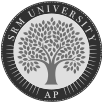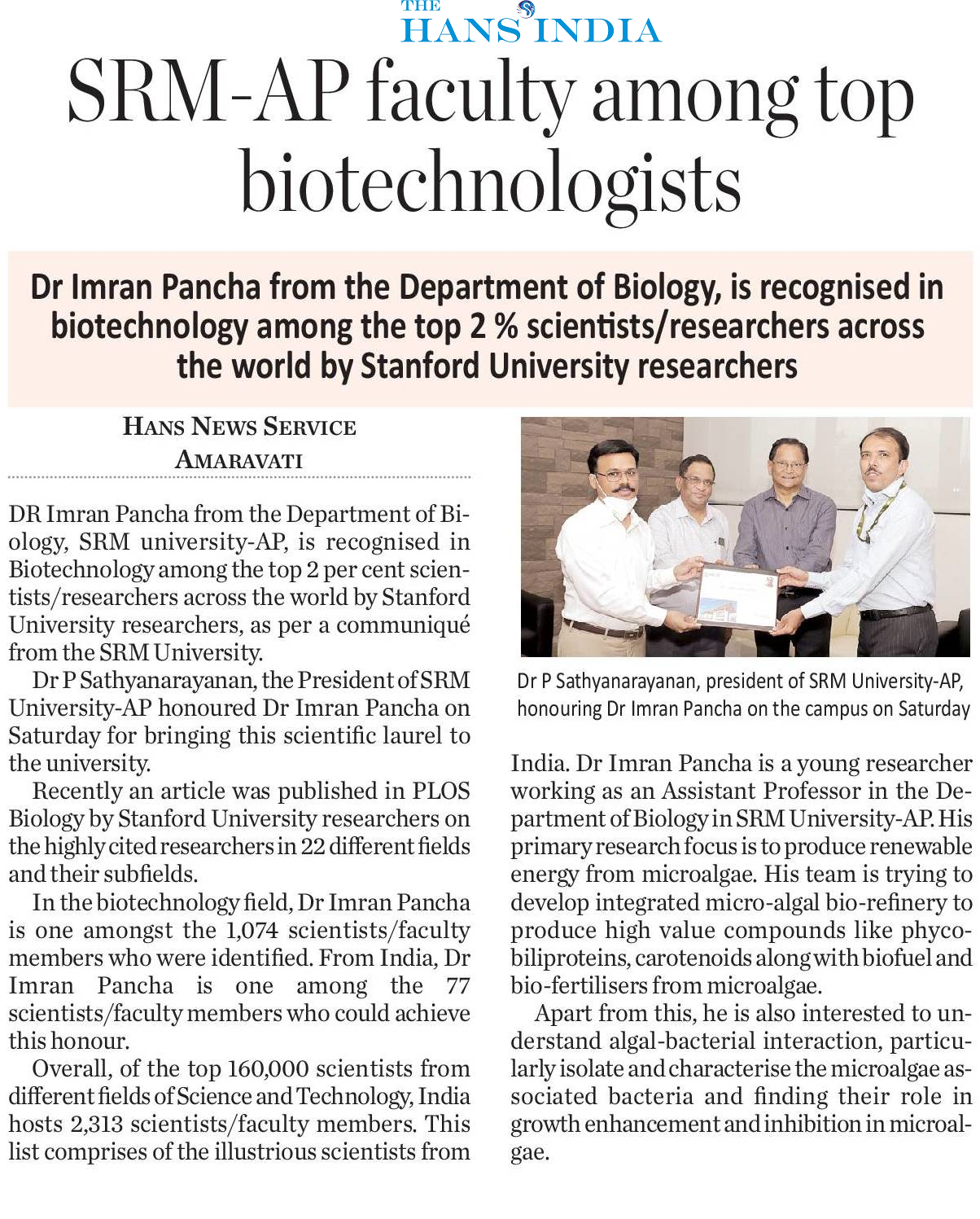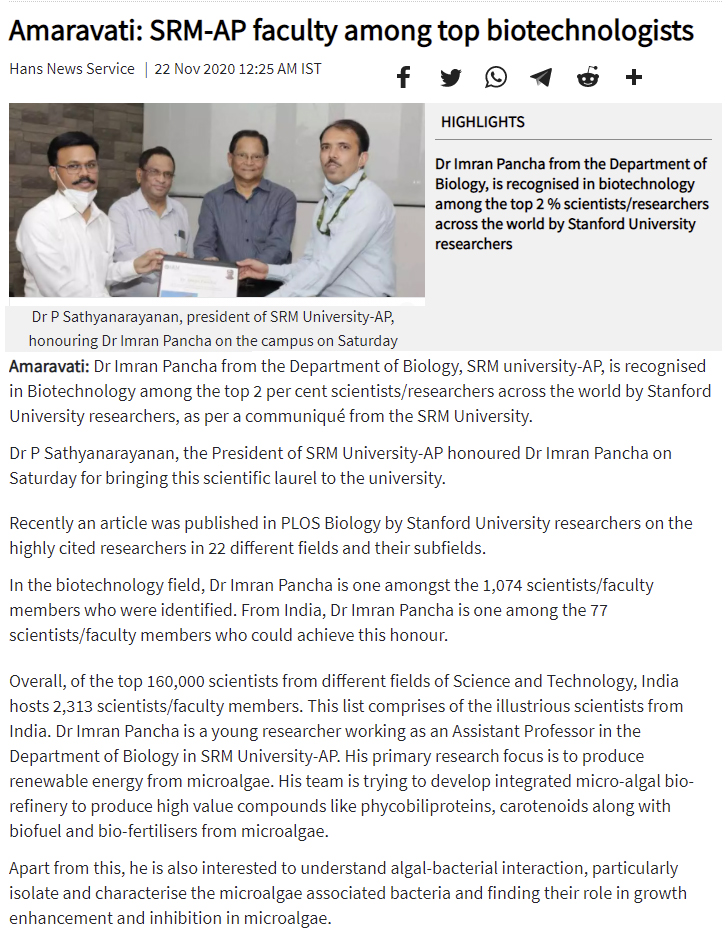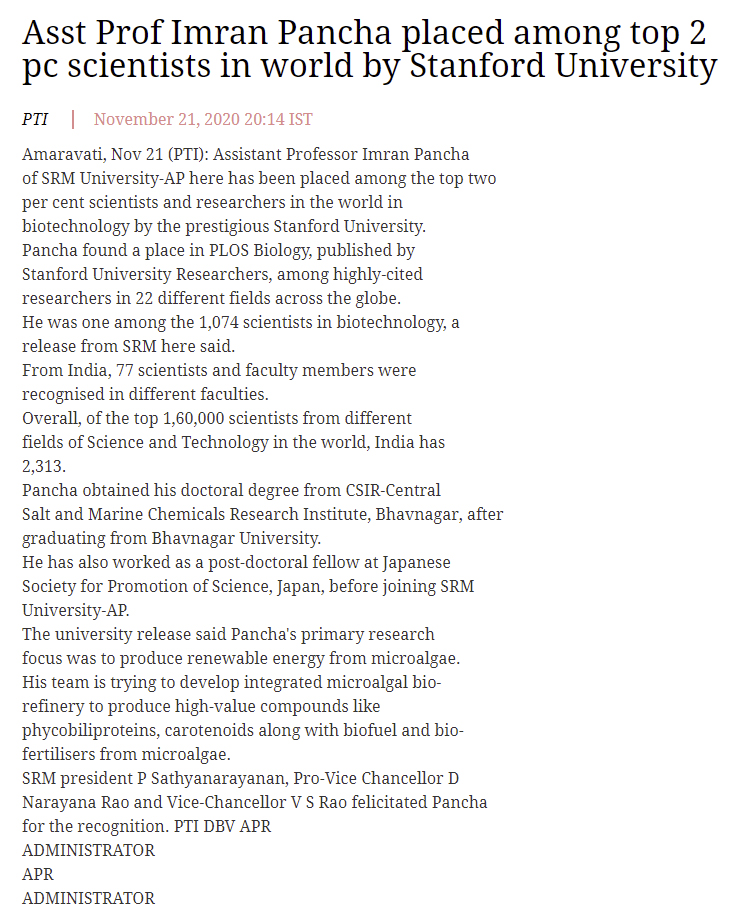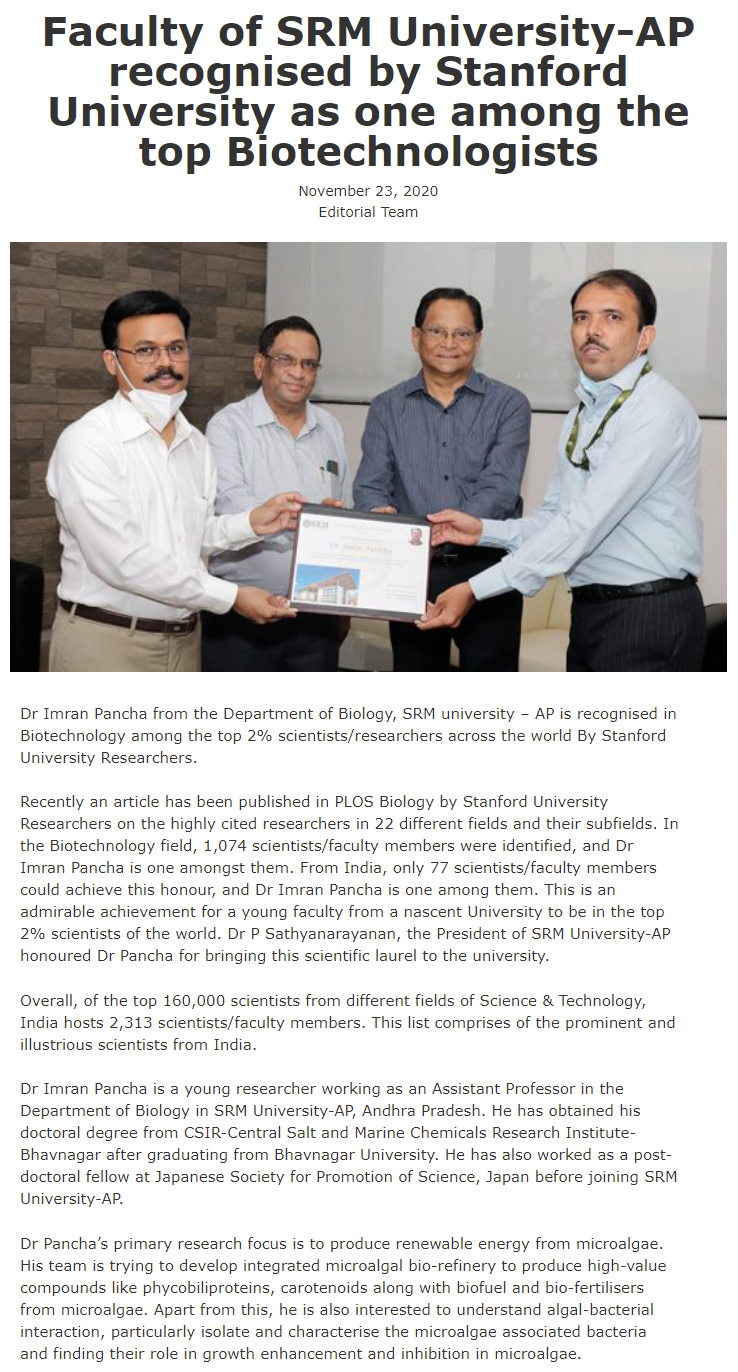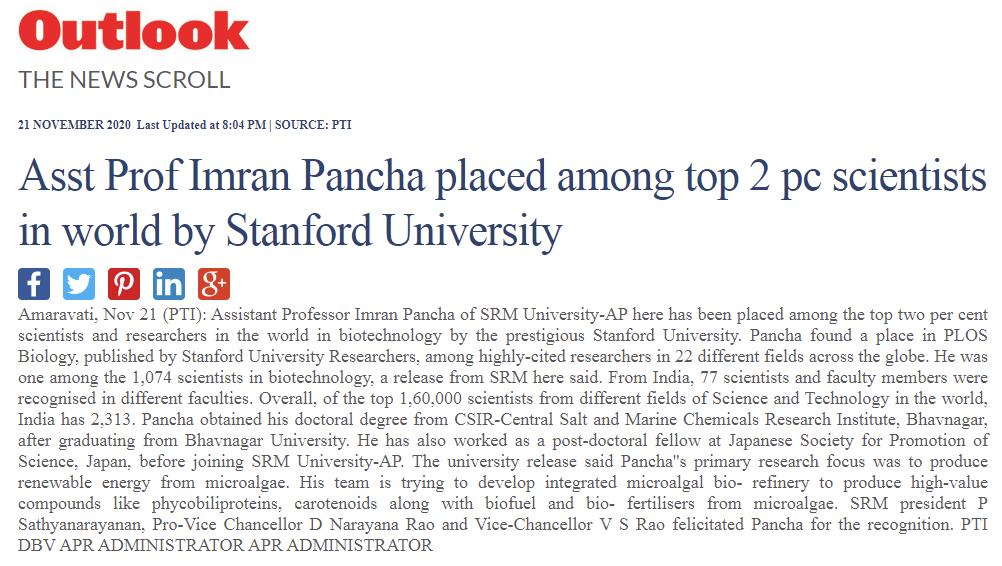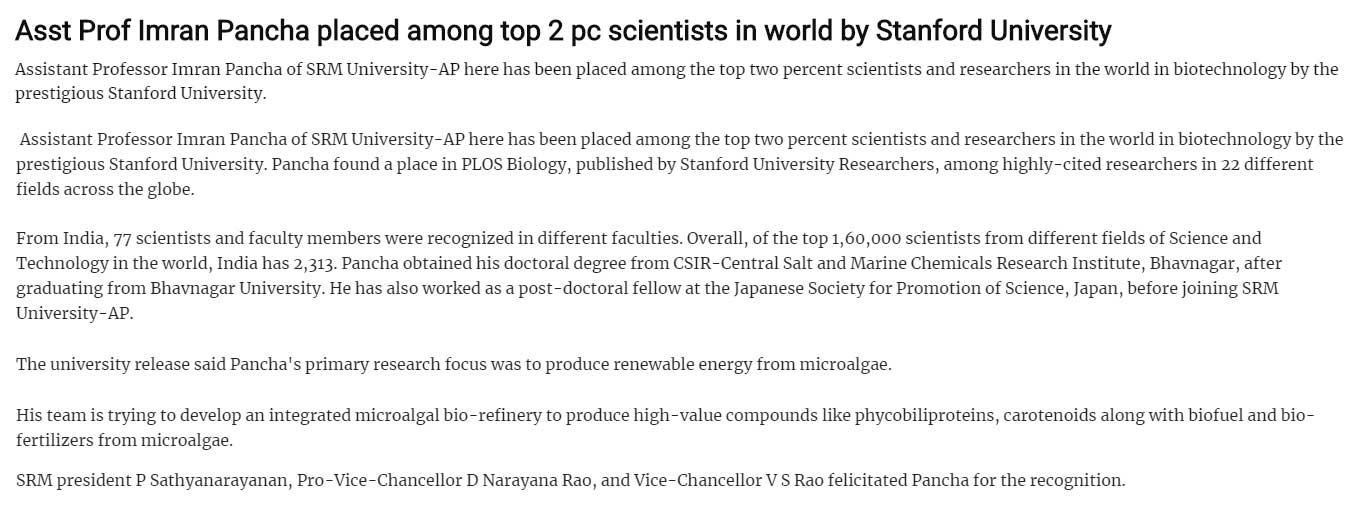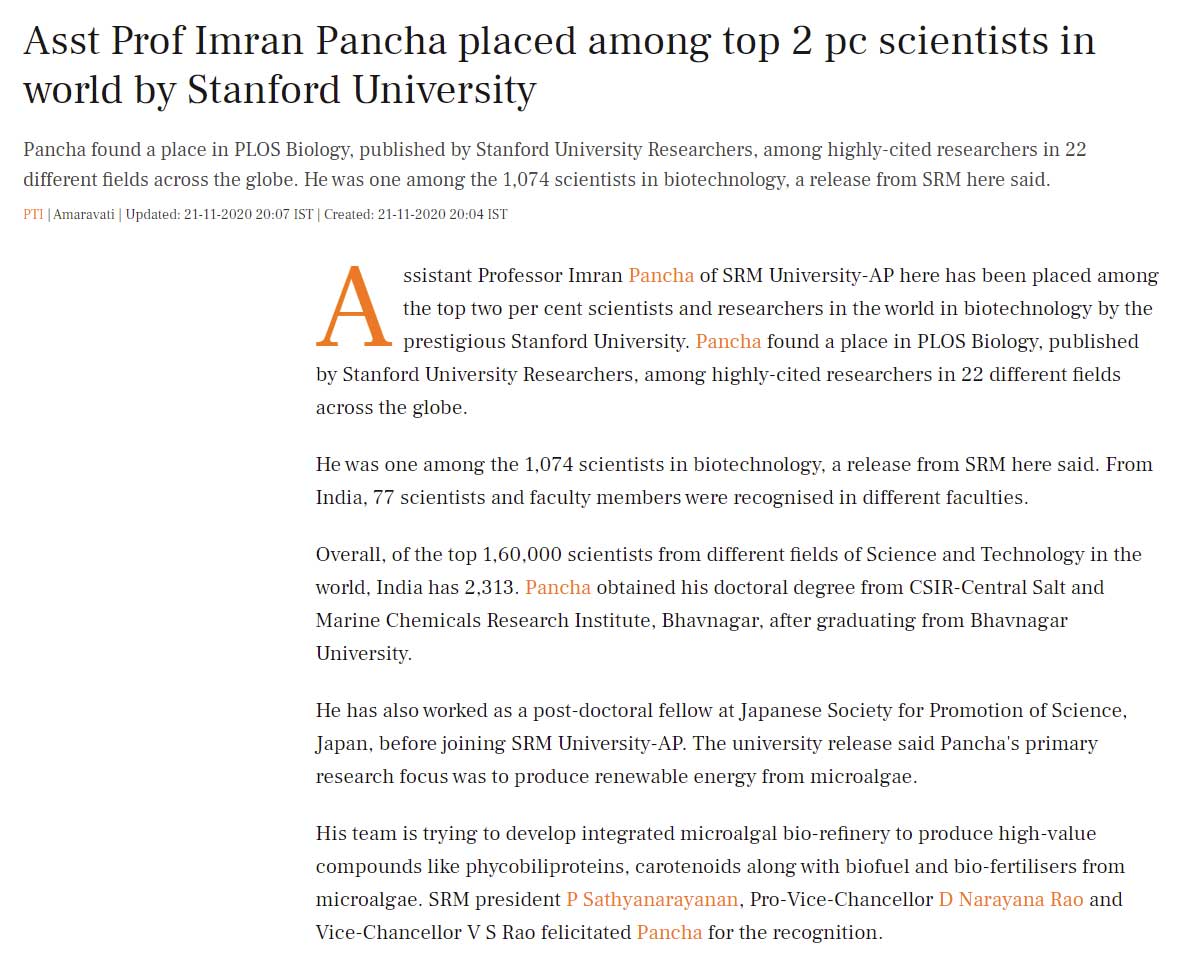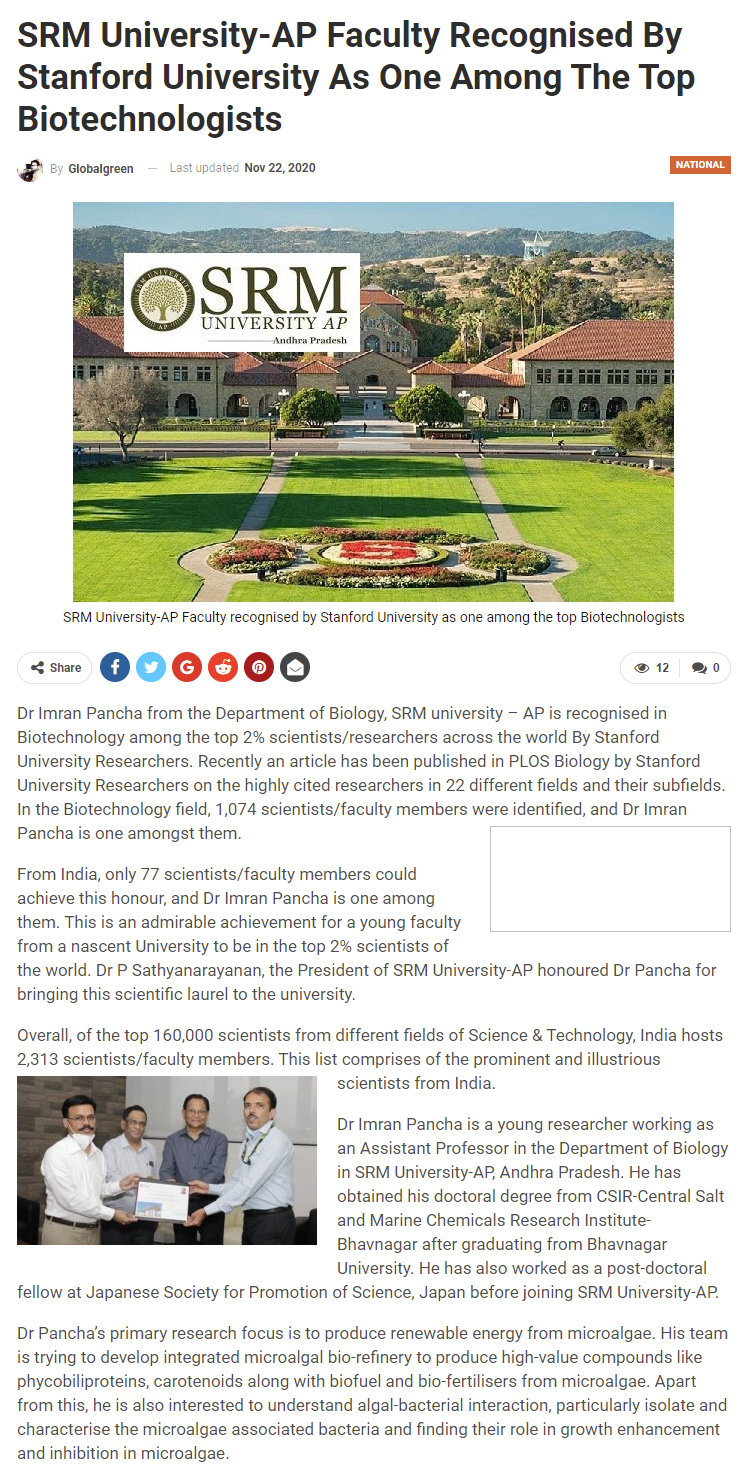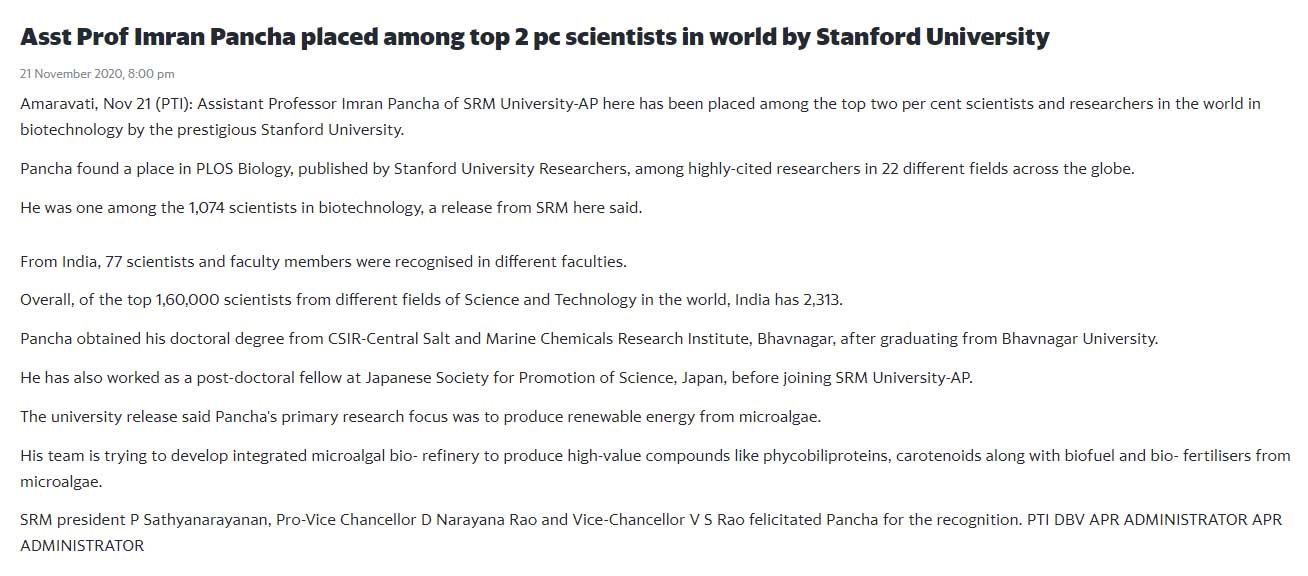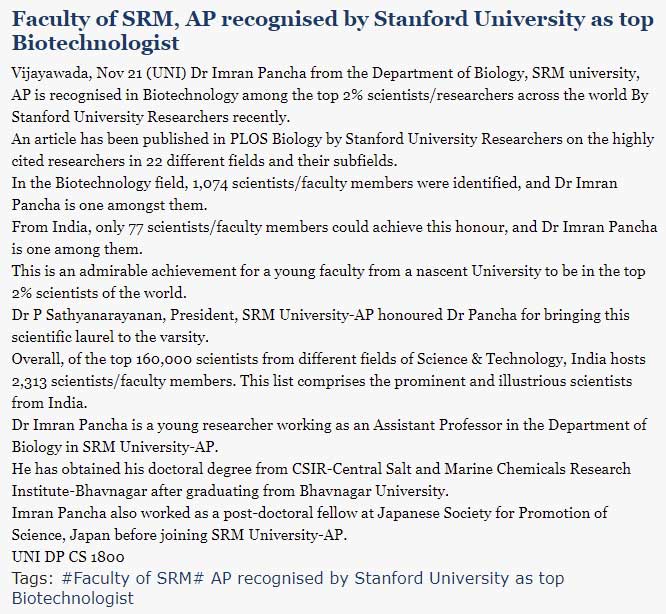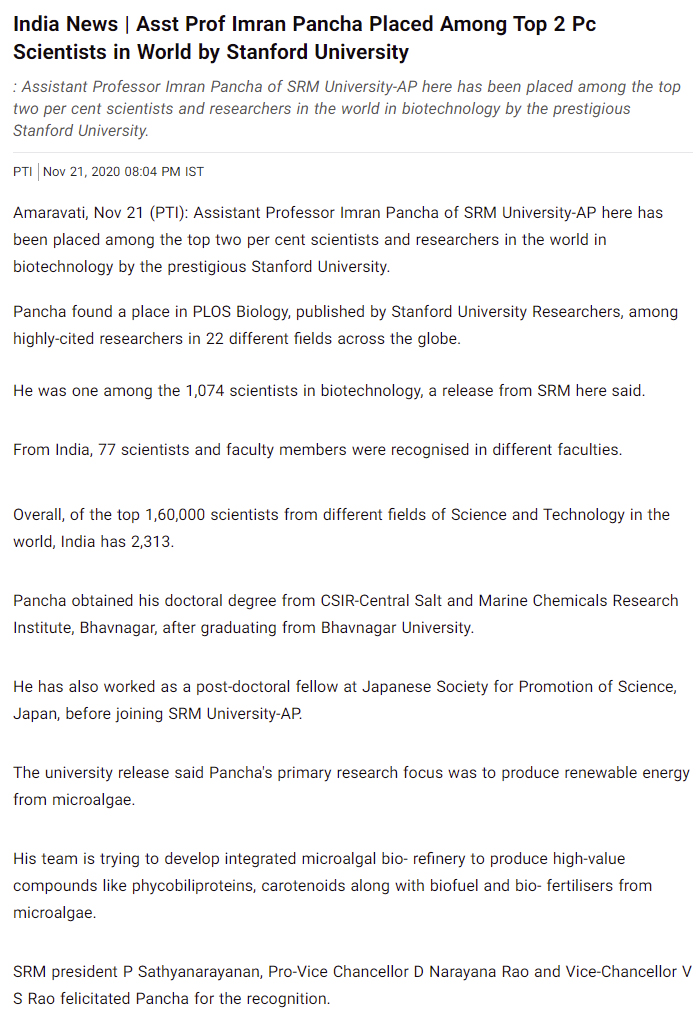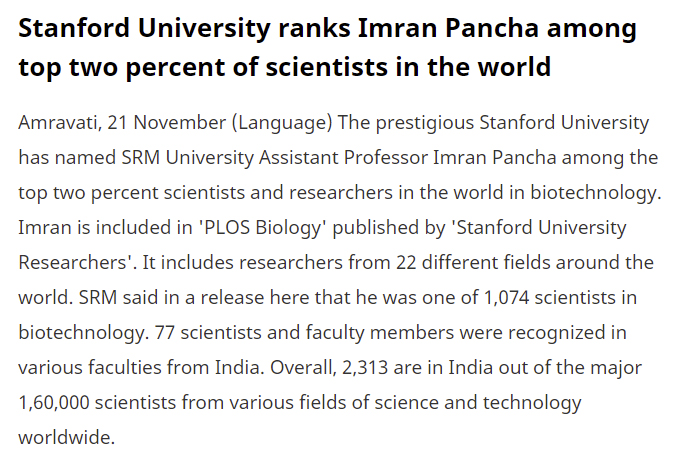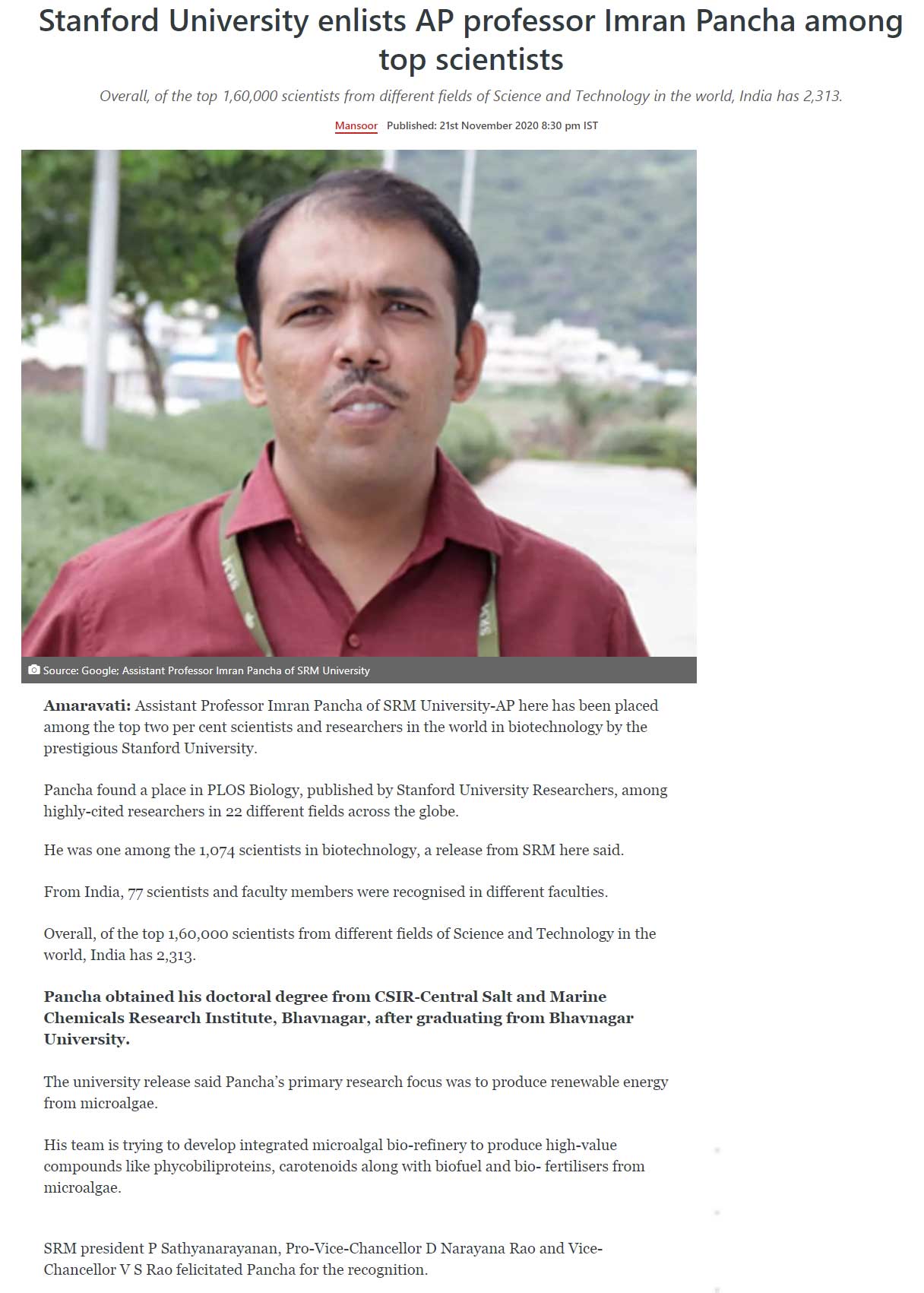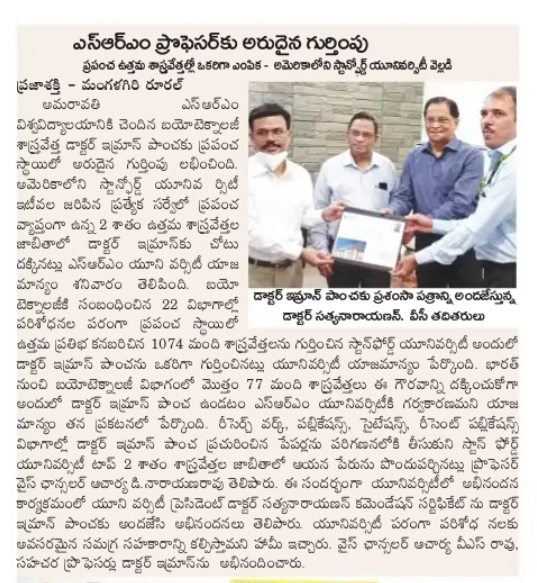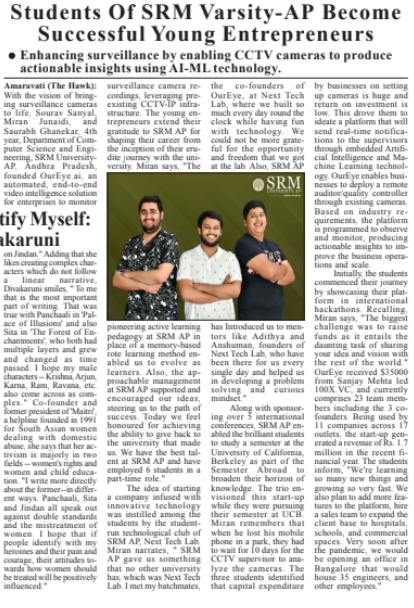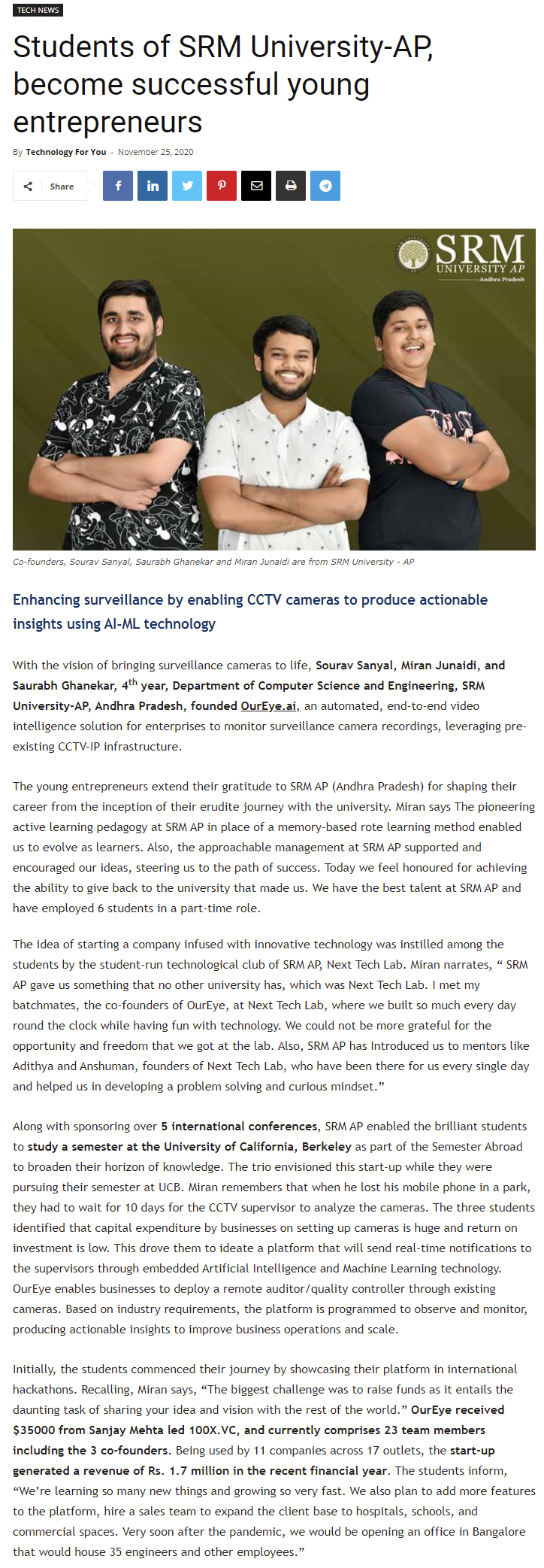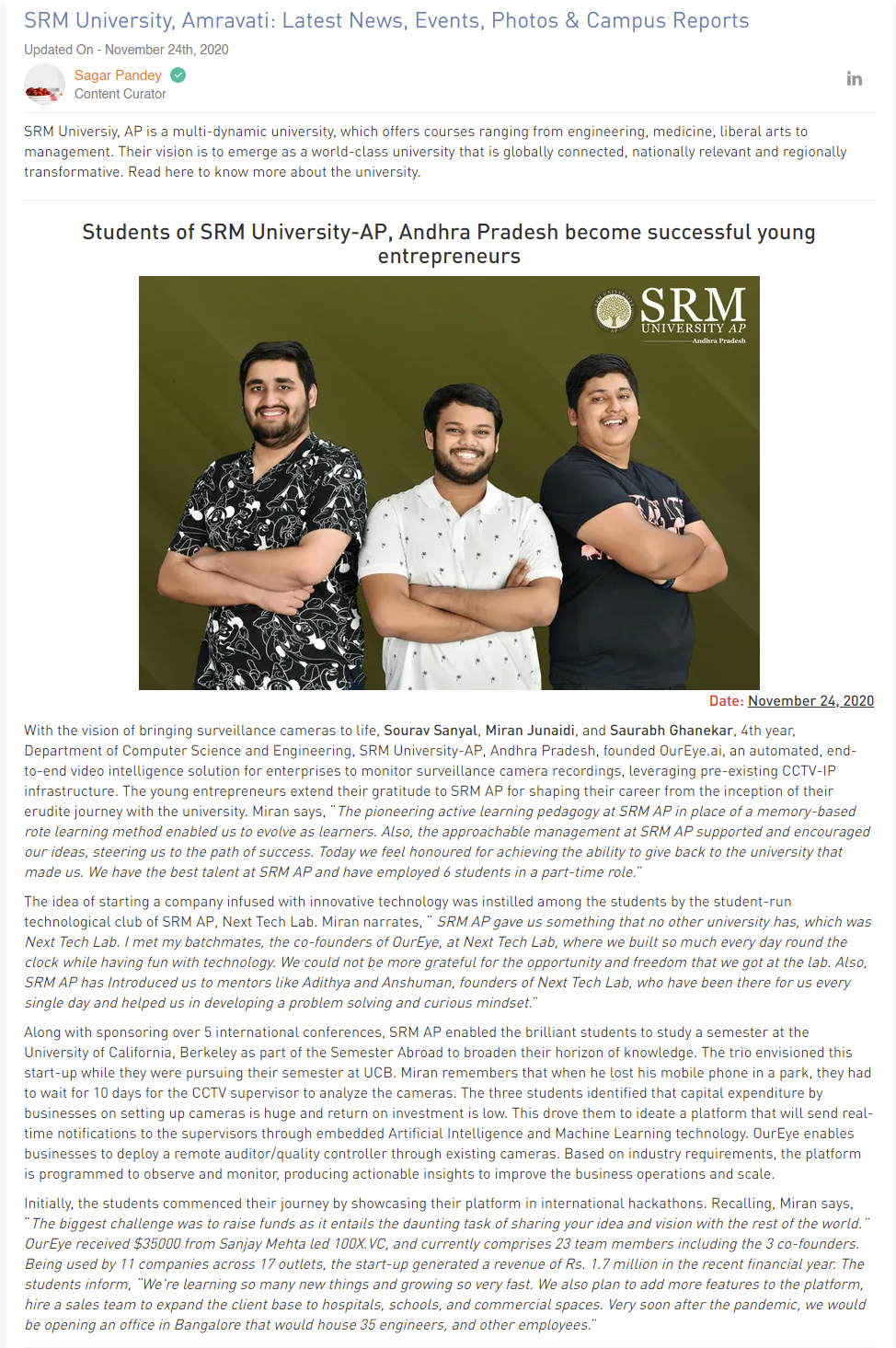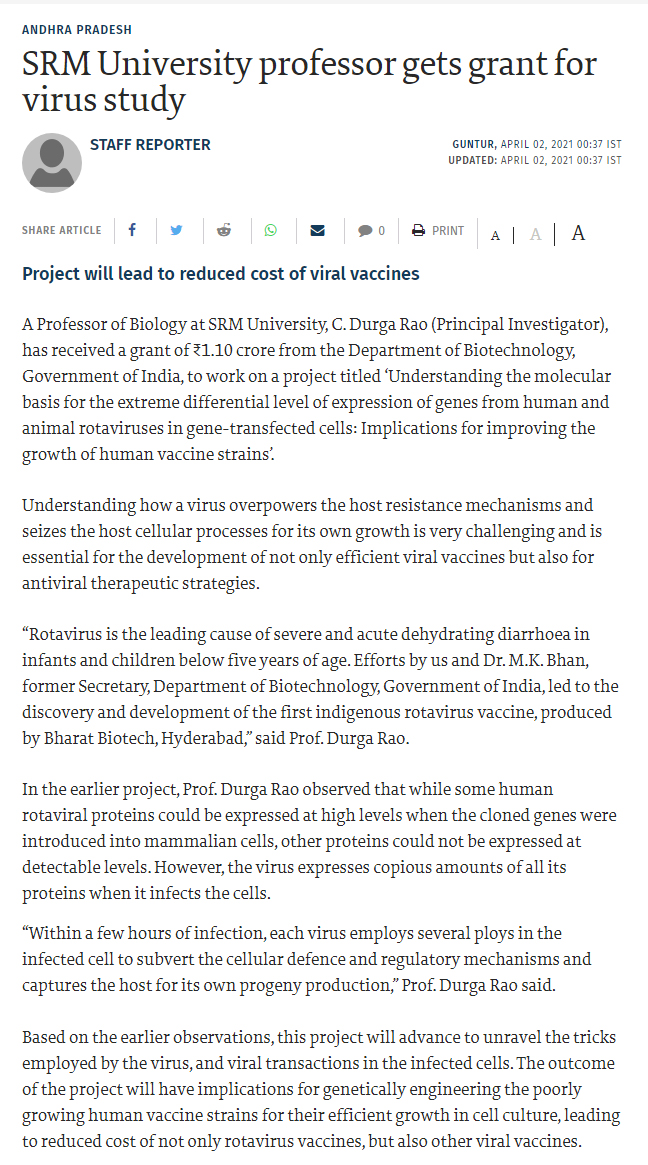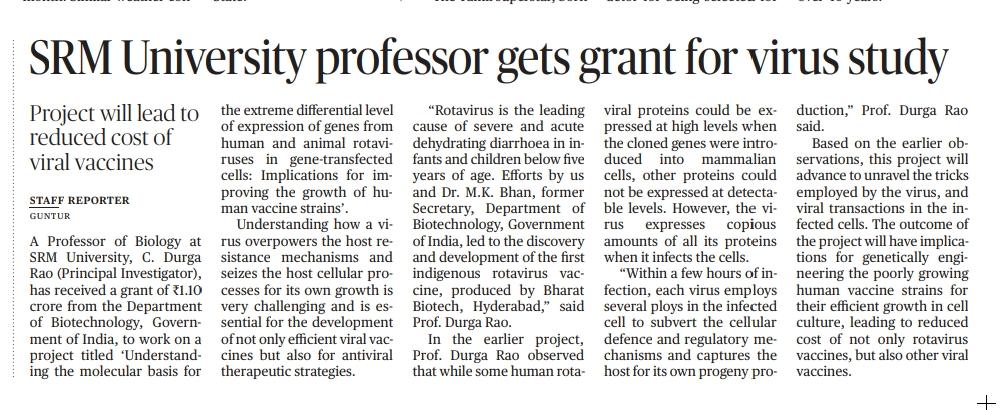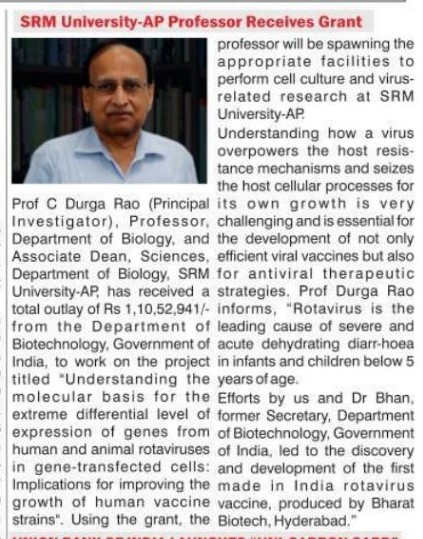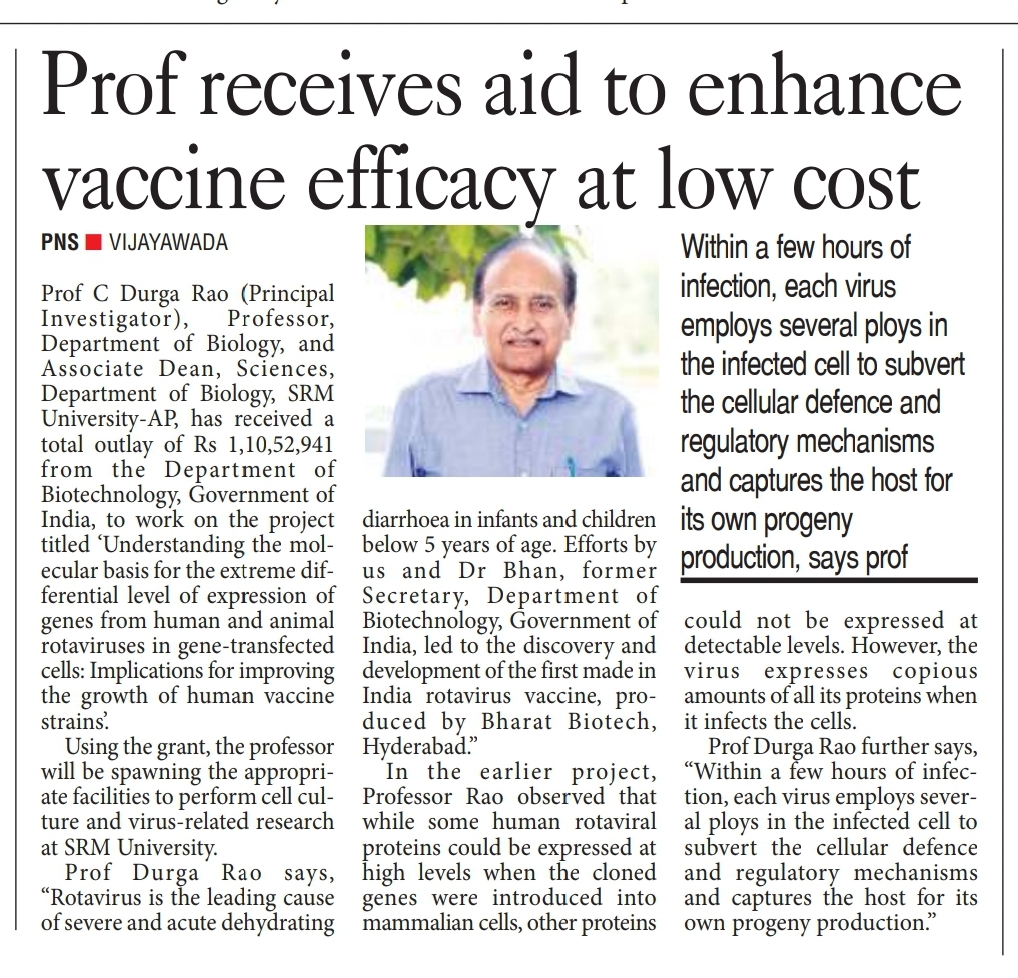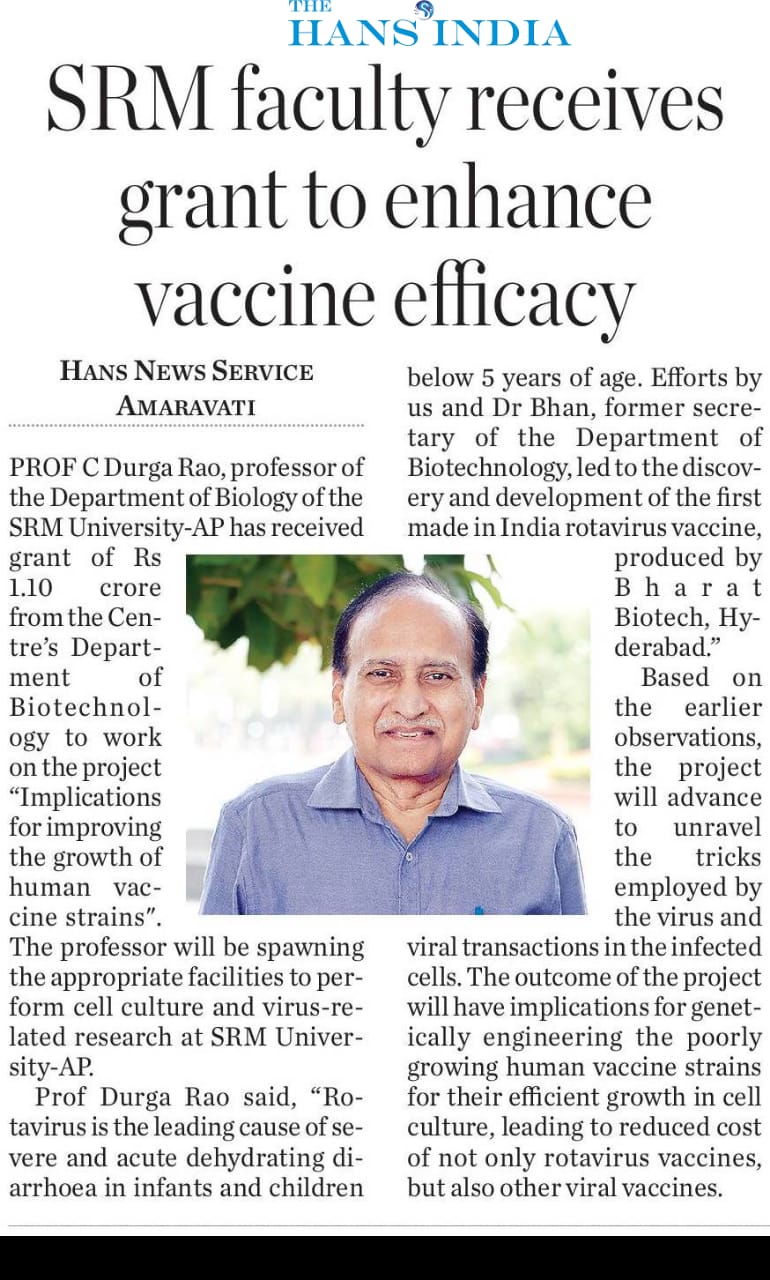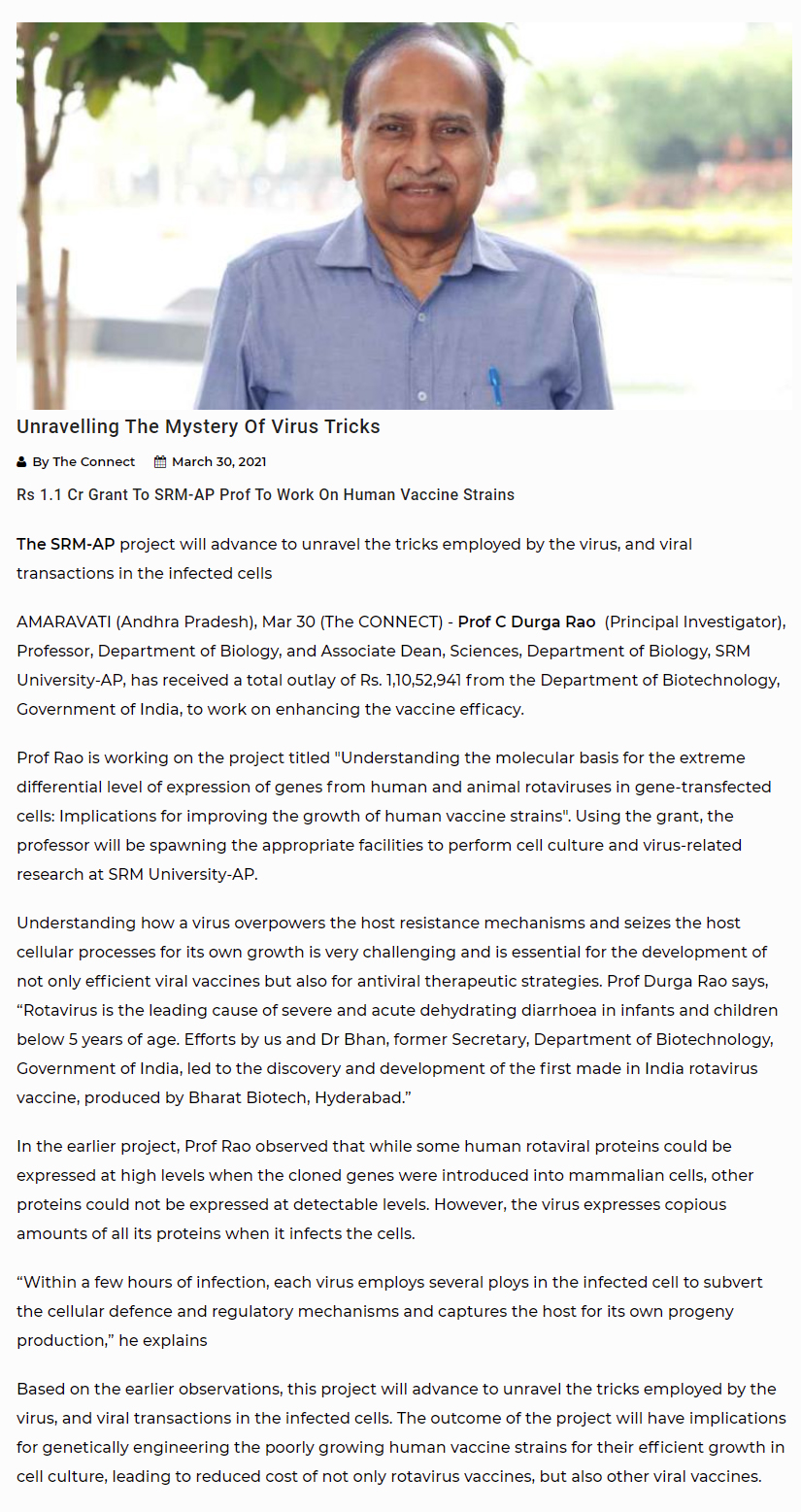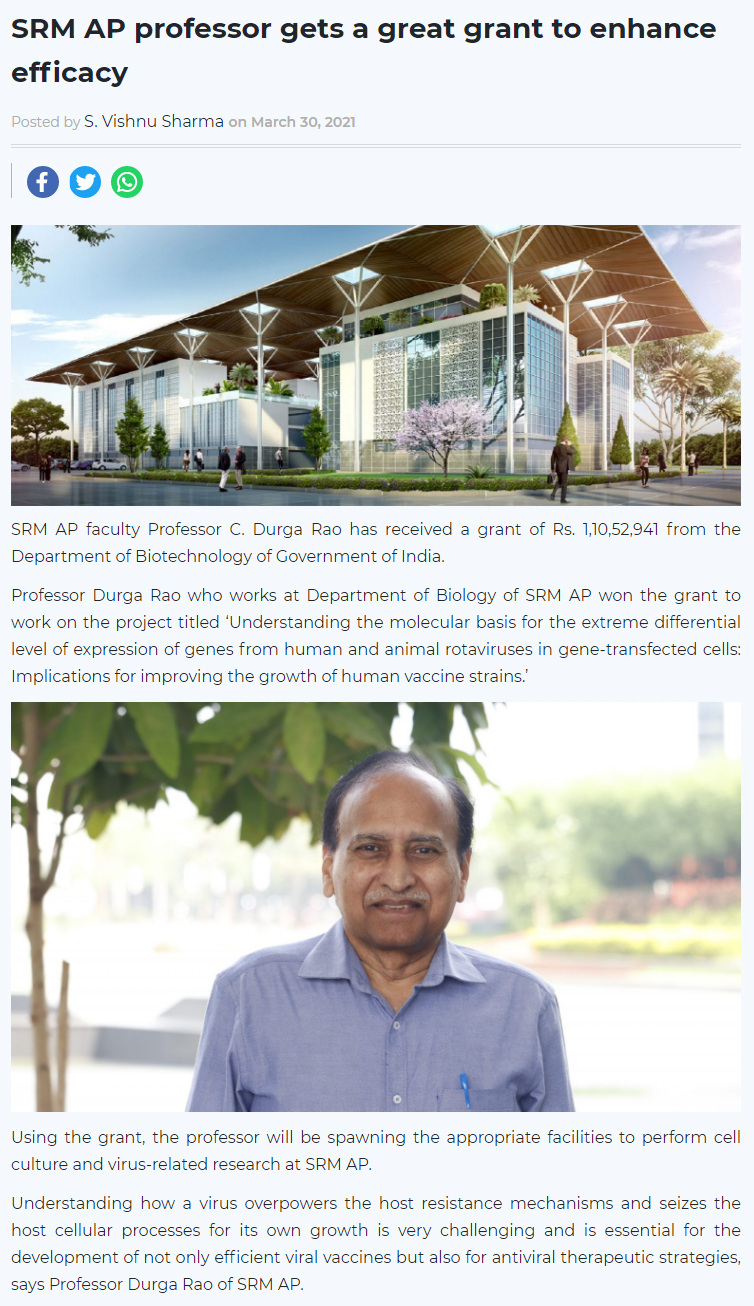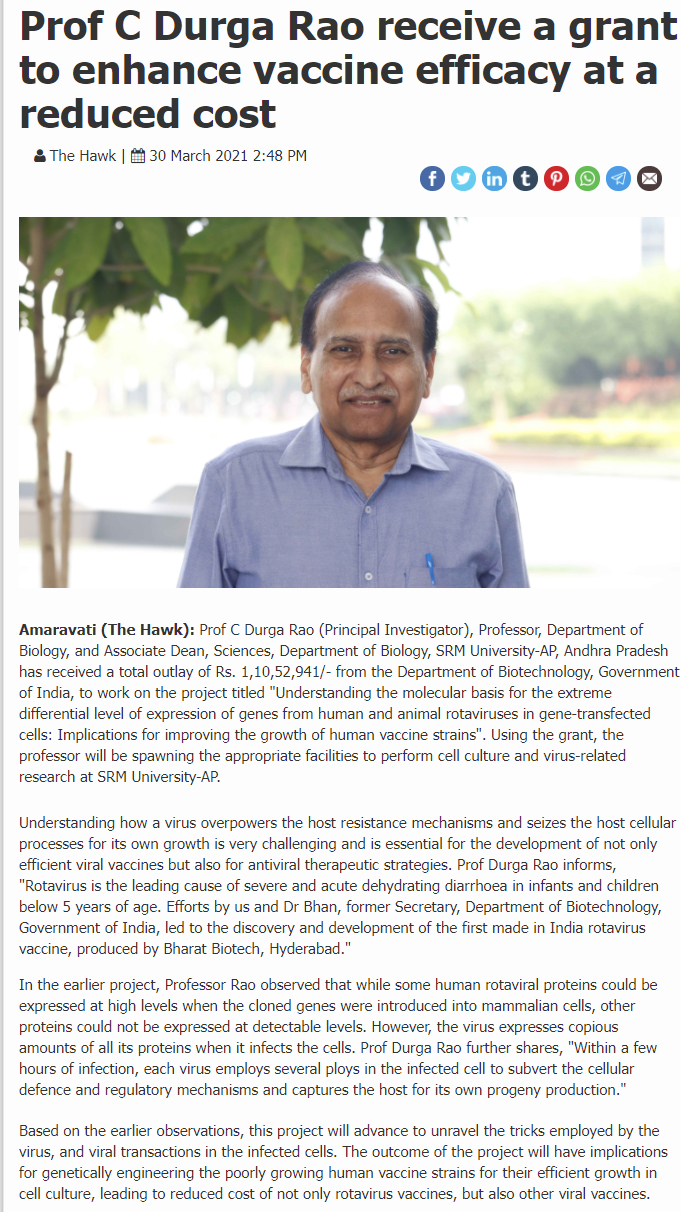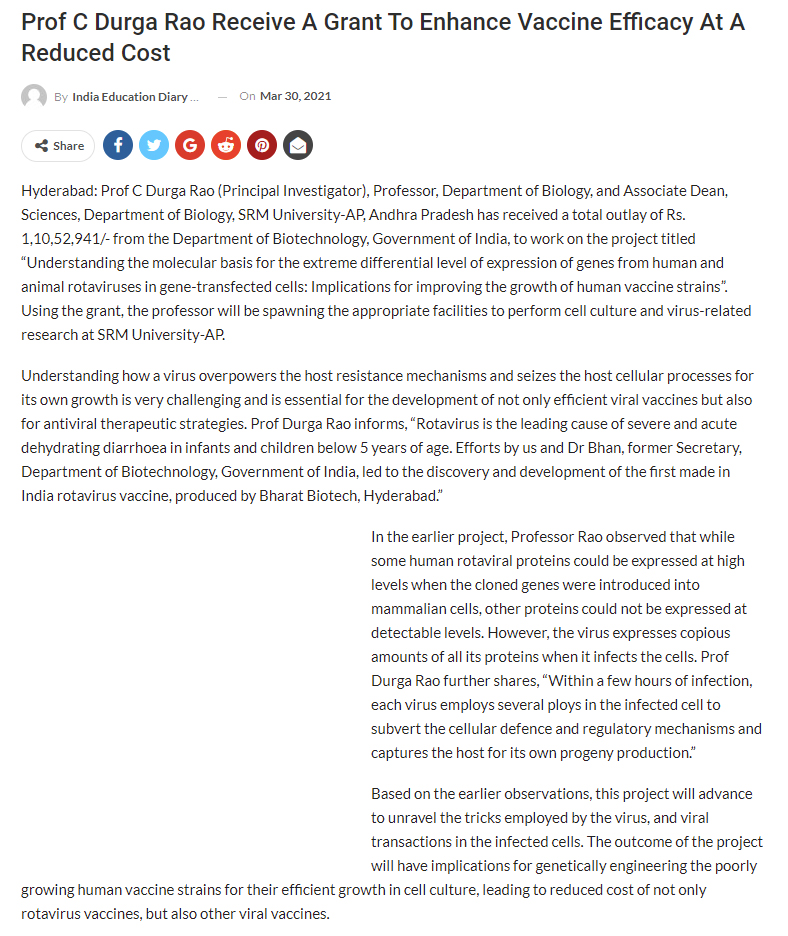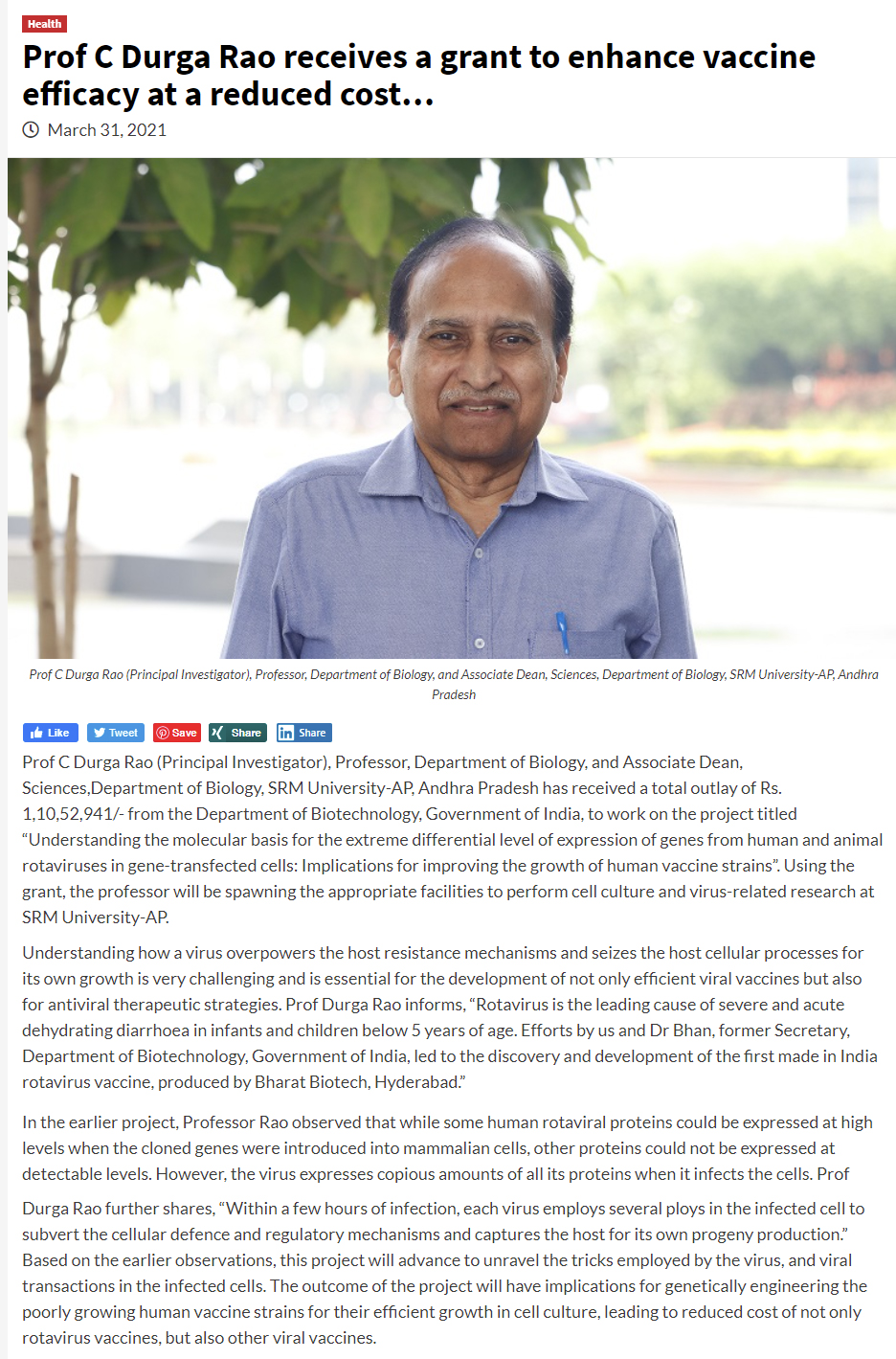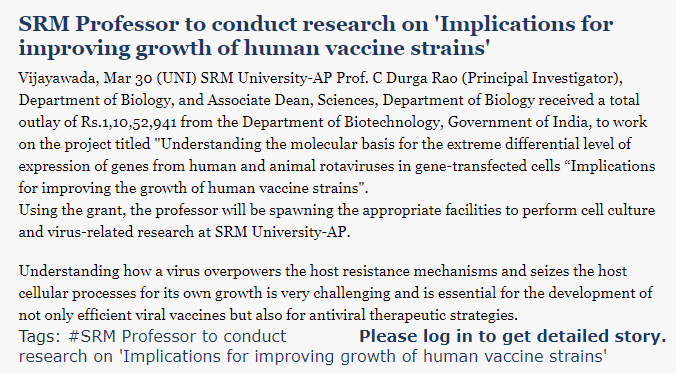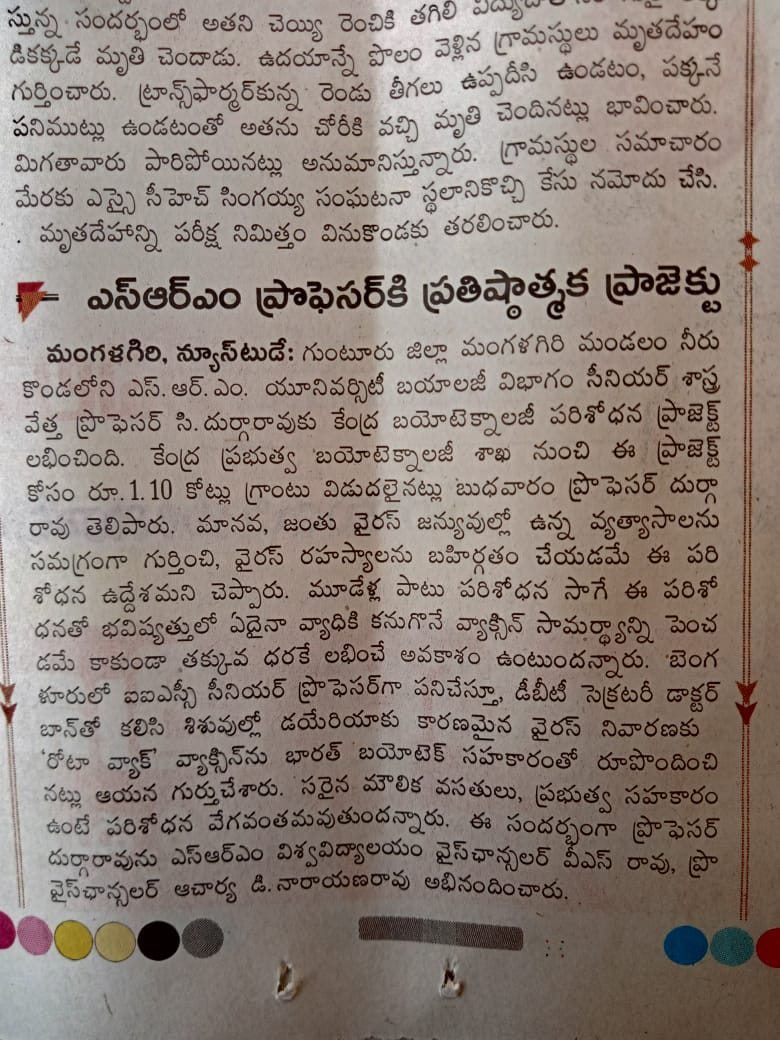Dr Writoban Basu Ball receives an outlay of Rs. 26.34 lakhs from DST, Government of India
Pursuit of discovering new drug molecules to combat diseases
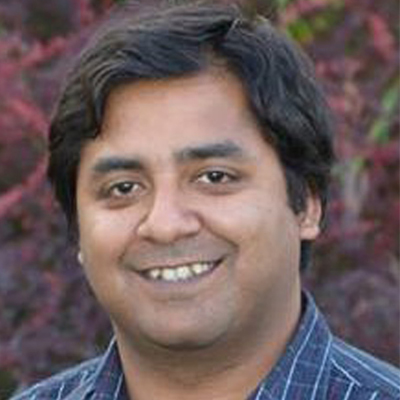
Dr Writoban Basu Ball, Assistant Professor, Department of Biological Sciences, received an outlay of Rs.26.34 lakhs from DBT, Government of India to pursue research on “Targeting Kennedy pathway of cellular phosphatidylethanolamine biosynthesis as a common therapeutic strategy against protozoan parasites like Leishmania donovani, Trypanosoma brucei and Entamoeba histolytica.” Disease-causing intracellular parasites present serious health challenges, which could be fatal if left untreated. For example, Leishmania donovani and Trypanosoma brucei are the causative agents of visceral leishmaniasis and sleeping sickness, respectively. Entamoeba histolytica causes amoebiasis and 100,000 people die each year world-wide from amoebiasis-related complications. The current treatment regimen against these diseases consists of drugs that possess severe toxicity and drug resistance. Toxicity is detrimental to health and drug-resistance causes unresponsiveness of the drug to the parasite, rendering the drug ineffective. Therefore, it has become imperative to discover new drug molecules to combat these diseases.
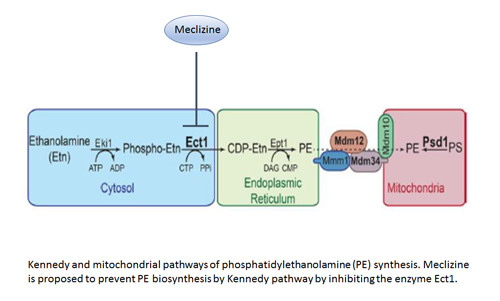 In his study, Dr Writoban proposes to repurpose an FDA-approved drug meclizine, which can be used as a potential drug against dreadful parasitic infections. He explains. “One rational way to discover new and effective drugs entails identifying pharmacological targets against unique yet essential parasite metabolic pathways which are either absent or redundant in hosts (in the present case humans). One such central metabolic pathway in L. donovani, T. brucei, and E. histolytica is the Kennedy pathway for the biosynthesis of phosphatidylethanolamine (PE), a major lipid molecule of the cell. Without the presence of this lipid molecule, the cellular membranes (plasma membrane, organellar membranes) cannot form. Therefore, the Kennedy pathway is indispensable to parasite survival. On the contrary, in humans, although the Kennedy pathway is present, other pathway of PE biosynthesis is predominant. Hence, the Kennedy pathway offers a potential target to disrupt PE biosynthesis in these parasites without causing any side effects in the human host. In this context, meclizine, an over the counter anti-nausea drug, has been shown to disrupt the Kennedy pathway.”
In his study, Dr Writoban proposes to repurpose an FDA-approved drug meclizine, which can be used as a potential drug against dreadful parasitic infections. He explains. “One rational way to discover new and effective drugs entails identifying pharmacological targets against unique yet essential parasite metabolic pathways which are either absent or redundant in hosts (in the present case humans). One such central metabolic pathway in L. donovani, T. brucei, and E. histolytica is the Kennedy pathway for the biosynthesis of phosphatidylethanolamine (PE), a major lipid molecule of the cell. Without the presence of this lipid molecule, the cellular membranes (plasma membrane, organellar membranes) cannot form. Therefore, the Kennedy pathway is indispensable to parasite survival. On the contrary, in humans, although the Kennedy pathway is present, other pathway of PE biosynthesis is predominant. Hence, the Kennedy pathway offers a potential target to disrupt PE biosynthesis in these parasites without causing any side effects in the human host. In this context, meclizine, an over the counter anti-nausea drug, has been shown to disrupt the Kennedy pathway.”
Dr Writoban’s research is oriented to find safe cures for dreadful parasitic diseases that mostly plagues the underprivileged section of the developing countries like India, and countries of the sub-Saharan Africa. He believes, “The successful implementation of the proposed research scheme would benefit a lot of underprivileged people belonging to the underdeveloped and developing countries, as well as reduce the disease burden of those countries.” Further, Dr Writoban emphasizes, “Getting the grant is only the job half done. I would like to guide this proposal to a fruitful completion so that it can benefit people who need it most. I really want to take this project beyond the bounds of a mere academic exercise.
- Published in News, Research News
DST, Government of India sanctions an outlay of Rs.14.63 lakhs to Dr Tapan Kumar Hota
Connecting the dots between Mathematics and Physics of the hydrodynamic instability known as Viscous Fingering (VF)
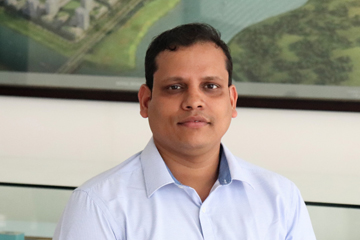
DST, Government of India, sanctioned a total outlay of Rs.14.63 lakhs to Dr Tapan Kumar Hota, Assistant Professor, Department of Mathematics, SRM University-AP, Andhra Pradesh, for pursuing research on “Mathematical analysis and Adjoint Based Stability for a Coupled Convection-Diffusion equation in Miscible Displacement”. Hydrodynamic Stability (Instability) is a study of an equilibrium point subject to small and/or medium disturbances. This assists in understanding several complicated natural phenomena such as fluid transition from laminar to turbulent, chemical mixing, formation of cloud, and others. The available stability analysis is unable to address the early-time evolution of the VF process. The early-time behaviour of the system helps us to choose the parameters that are responsible for the long-time behaviour of the coupled PDEs. To achieve the target, we need to address the linear stability of the system from the study of the singular-value-decomposition instead of traditional eigenvalue analysis. As the system is non-autonomous, the eigenvectors/eigenvalues may not be physically relevant. Further, it is required to confirm our linear stability analysis by mathematical analysis of the coupled non-linear PDEs.
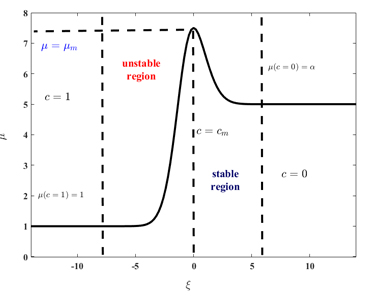

‘The nonmonotonic viscosity profile when a high mobile fluid is displacing a less mobile fluid. There is a potentially unstable region, where the viscosity increases in the flow direction, followed in the downstream direction by a potentially stable region, where the viscosity decreases in the flow direction. The disturbance structure is computed using the singular-value decomposition of the propagator matrix. Reference: Hota & Mishra, Journal of Fluid Mech, Vol. 856, pp:552-579, 2018.’
Dr Tapan is keen on studying other branches of science to provide the correct mathematical approach to address the issues. His project will address one of the hydrodynamic instabilities known as viscous fingering (VF). It forms when a high mobile fluid displaces a low mobile fluid. It has enormous implications in the field of Chemical Engineering Science, Petroleum Engineering, Chromatography, and Oil Extraction process. He explains, “I will study this instability from a mathematician’s point of view, more precisely, to address the mathematical analysis of coupled partial differential equations (PDEs). The system that governs the VF is non-autonomous and there is no readily available stability analysis that can represent Physics, based on robust mathematical analysis. My aim is to connect the dots between mathematics and physics of the VF.”
Infrastructure and laboratory facilities are crucial to conduct research. Upon receiving approval from a prestigious organization like SERB (Science and Engineering Research Board), Govt. of India, Dr. Tapan is entitled to this unique opportunity to serve the scientific community. He divulges, “The award is not only a recognition to me but also to the SRM University, AP. The University will be more visible in the world of research and can attract more eminent scientists and researchers to make the University their second home.” Quoting Master Oogway, ‘Yesterday is history, Tomorrow is a mystery… Today is a gift, that’s why it is called present.’, Dr Tapan is eager to commence working on his project at the earliest, and looks forward to enjoying the process of accomplishing the task.
- Published in Math News, News, Research News
SRM AP in collaboration with IIT, Chicago presents webinar on “Education Opportunities at Illinois Institute of Technology, Chicago, USA”
 SRM University-AP, Andhra Pradesh along with Illinois Institute of Technology, Chicago, USA, is delighted to organize a webinar on “Education Opportunities at Illinois Institute of Technology, Chicago, USA”. The session will provide insights on the Twinning programme ideal for the current first and second year students, along with the Integrated Master’s programme that would be beneficial for the current third and final year students. Students are encouraged to participate in the webinar on October 16, 2020 at 5 p.m. for obtaining further information on the programmes, benefits of the programmes, and application process.
SRM University-AP, Andhra Pradesh along with Illinois Institute of Technology, Chicago, USA, is delighted to organize a webinar on “Education Opportunities at Illinois Institute of Technology, Chicago, USA”. The session will provide insights on the Twinning programme ideal for the current first and second year students, along with the Integrated Master’s programme that would be beneficial for the current third and final year students. Students are encouraged to participate in the webinar on October 16, 2020 at 5 p.m. for obtaining further information on the programmes, benefits of the programmes, and application process.
Registration Link: Please Click Here
For further details, Contact Dr. Sunil Chinnadurai
- Published in Events
Assistant Prof Imran Pancha Placed Among Top 2 Pc Scientists in World by Stanford University
- Published in Newsroom
Students of SRM Varsity-AP Become Successful Young Entrepreneurs
The New Indian Express – Dec 08
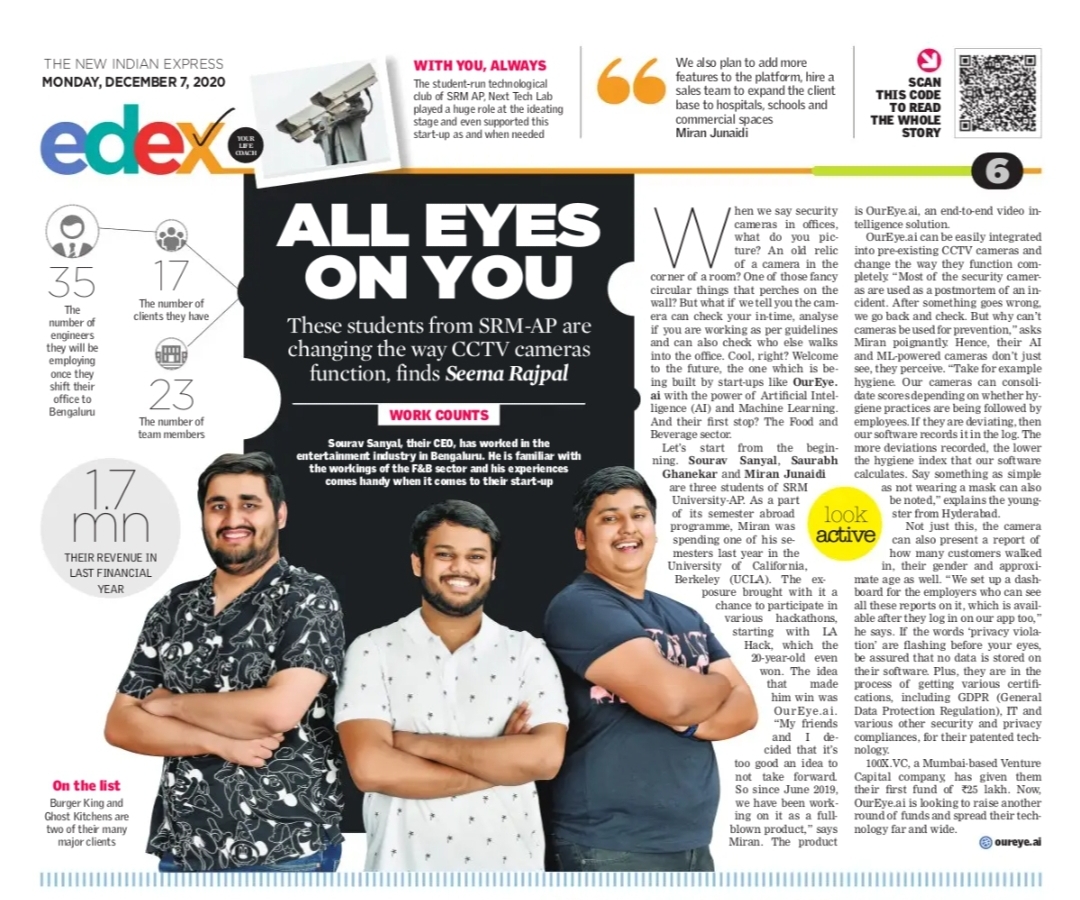
The Hindu – Nov 25
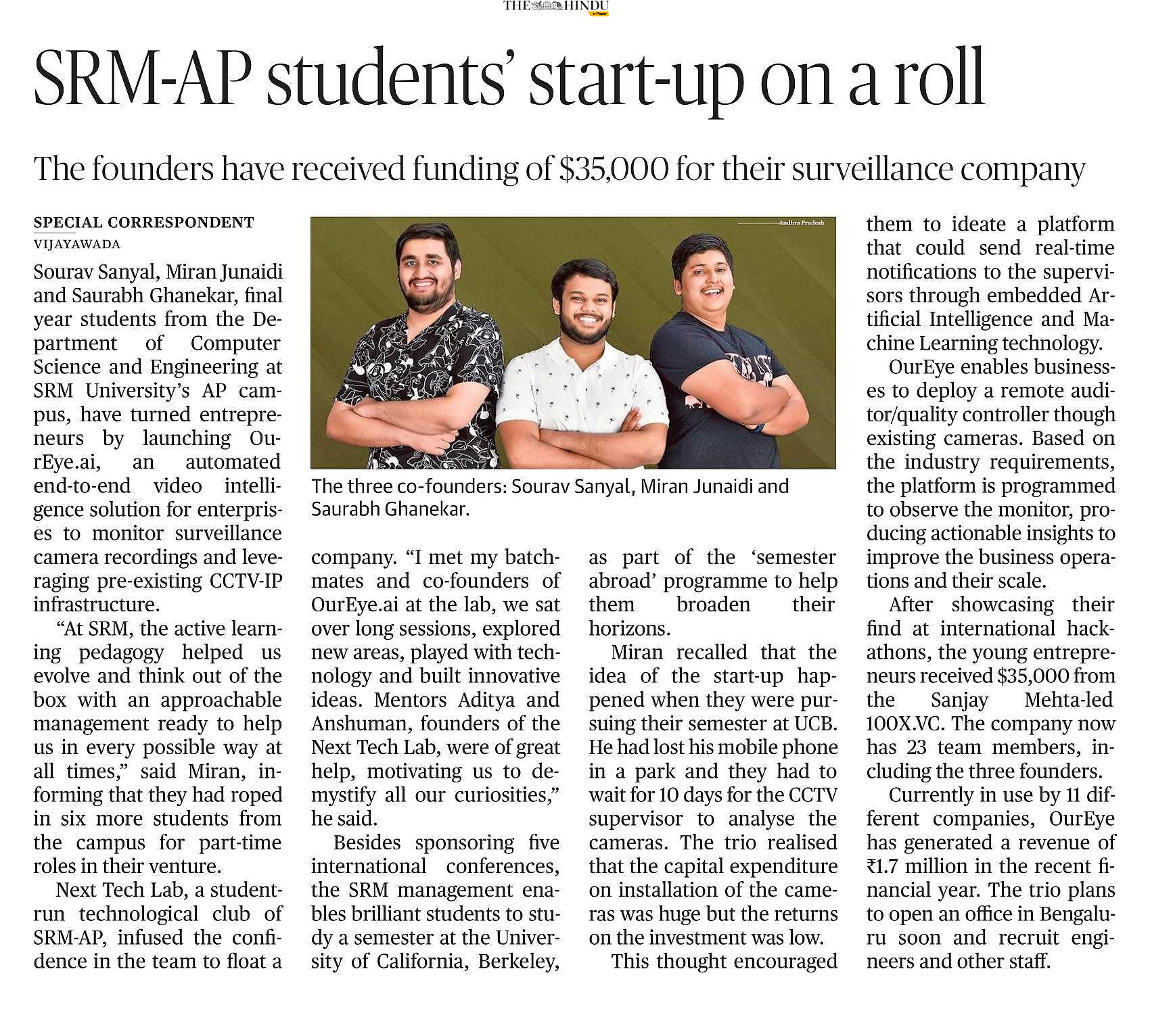
The Hans India – Nov 25
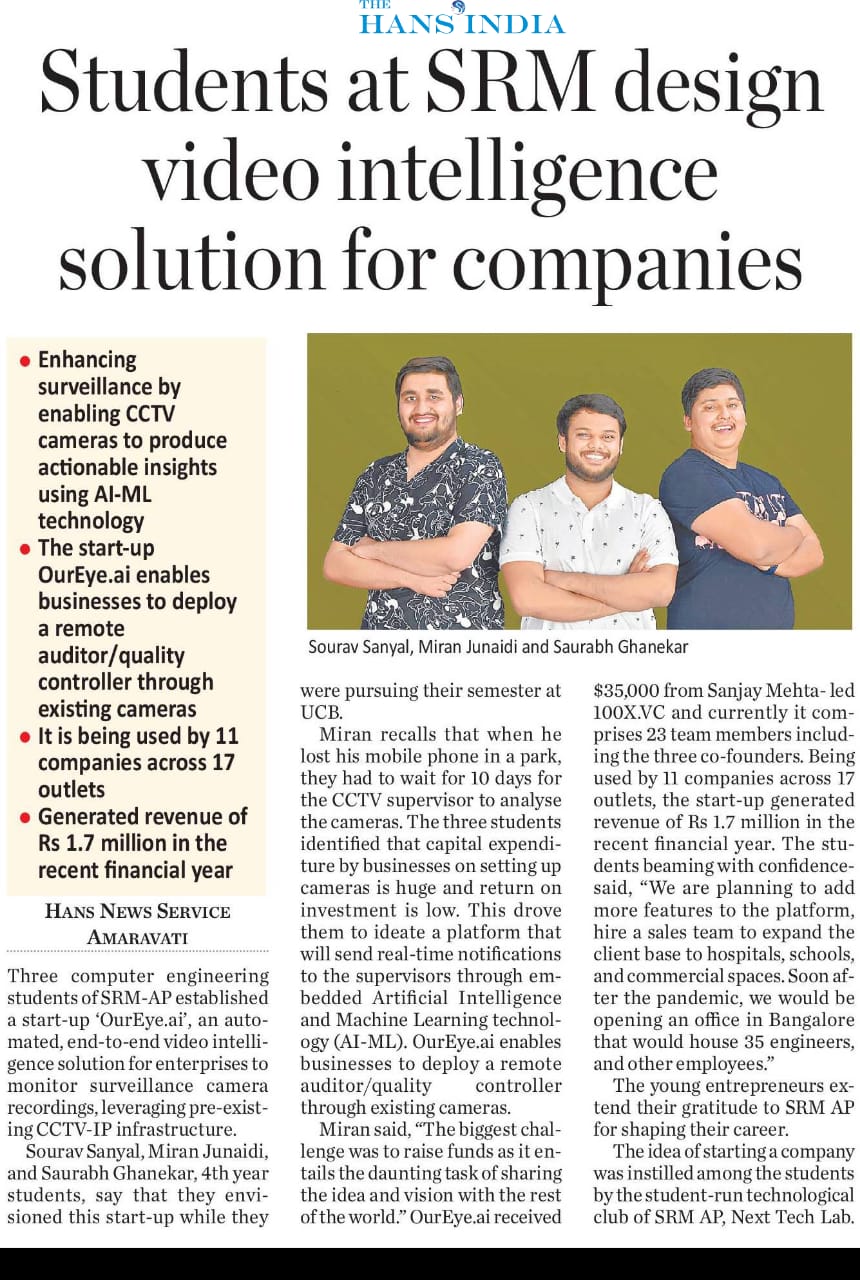

Daily Pioneer – Nov 25
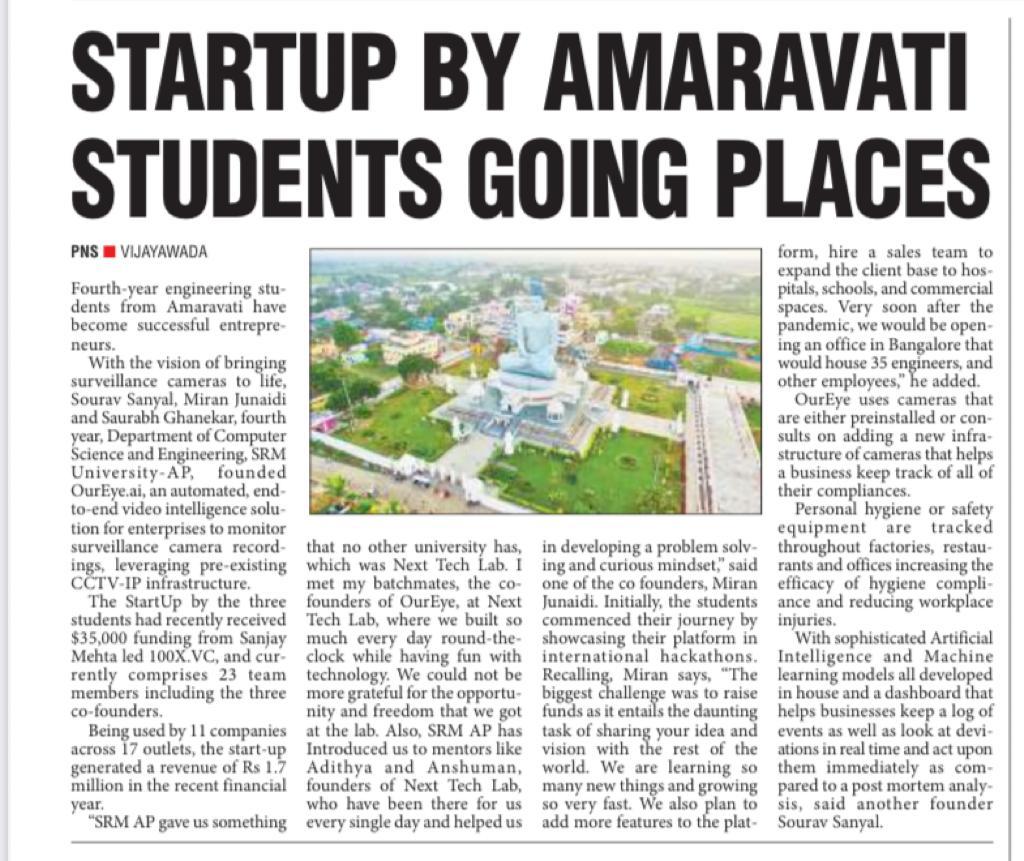
Higher Education Digest – Nov 25

Business News This Week – Nov 25
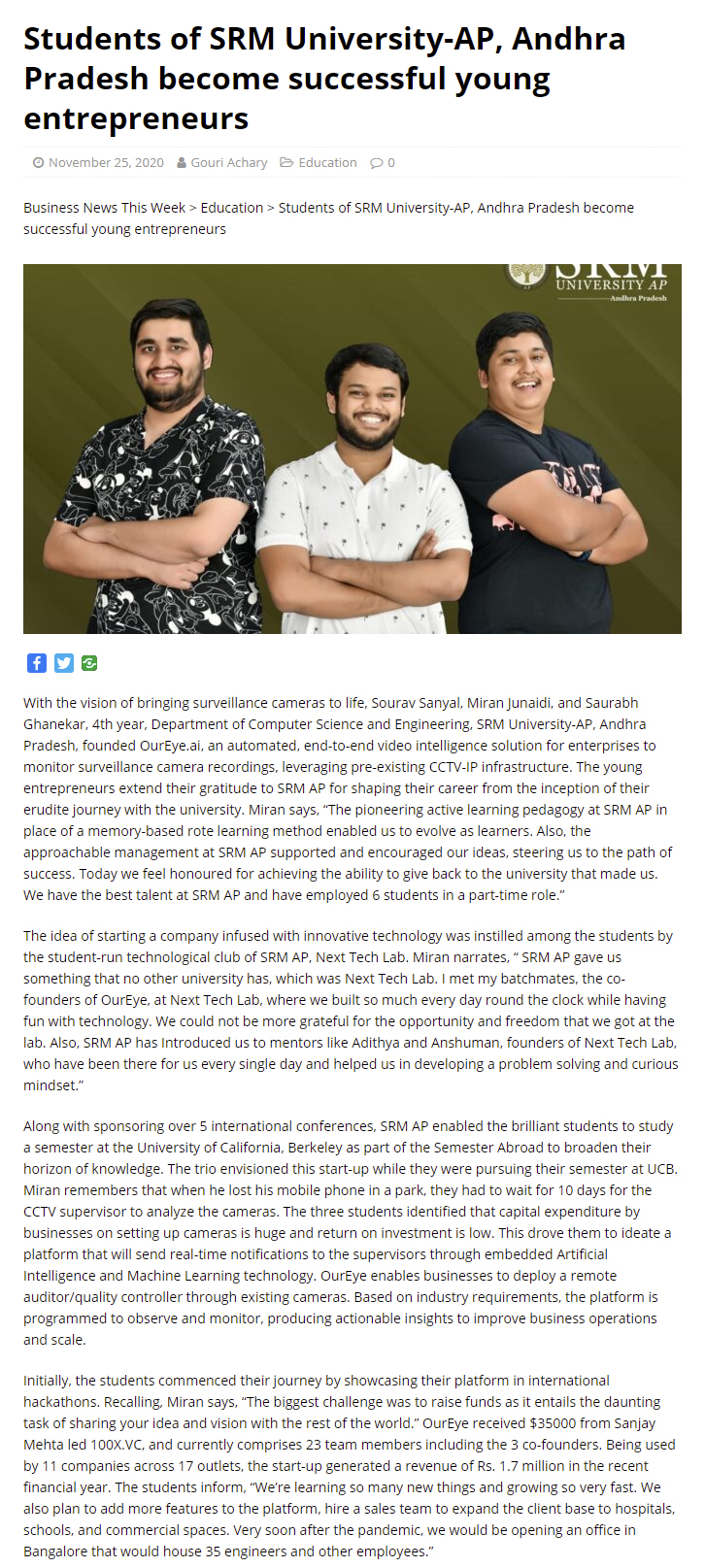
India Education Diary – Nov 25
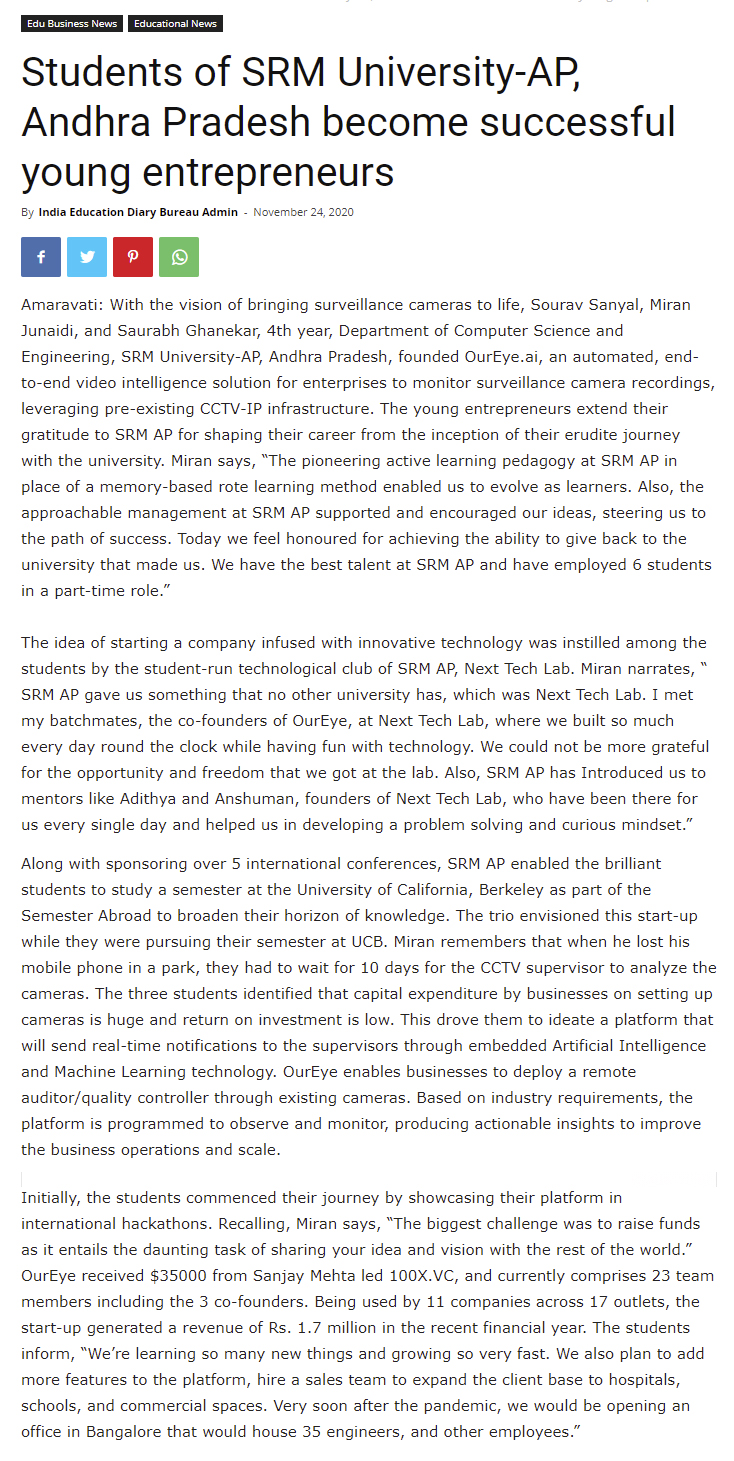
Trinity Mirror – Nov 25
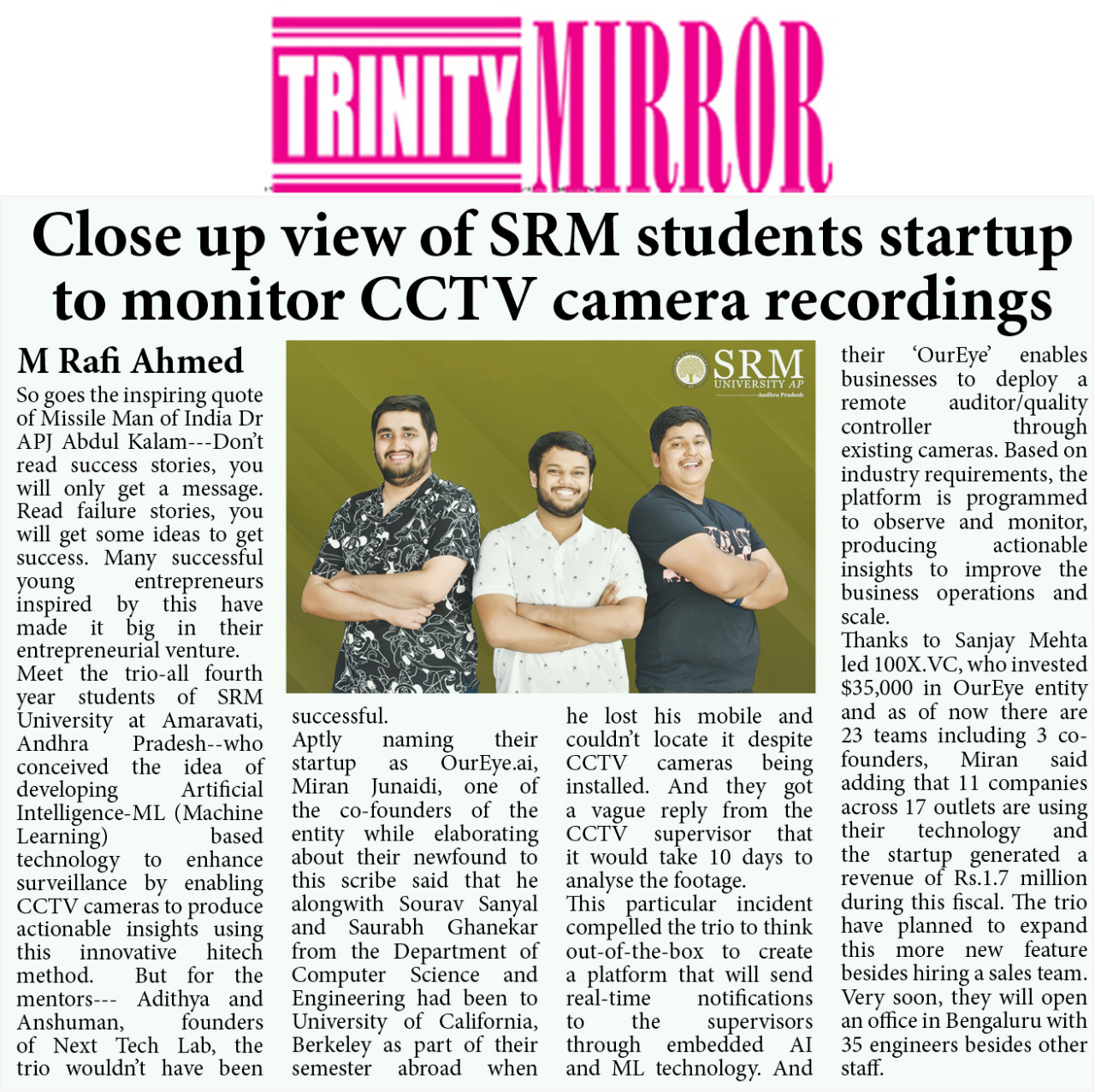
Manam – Nov 25
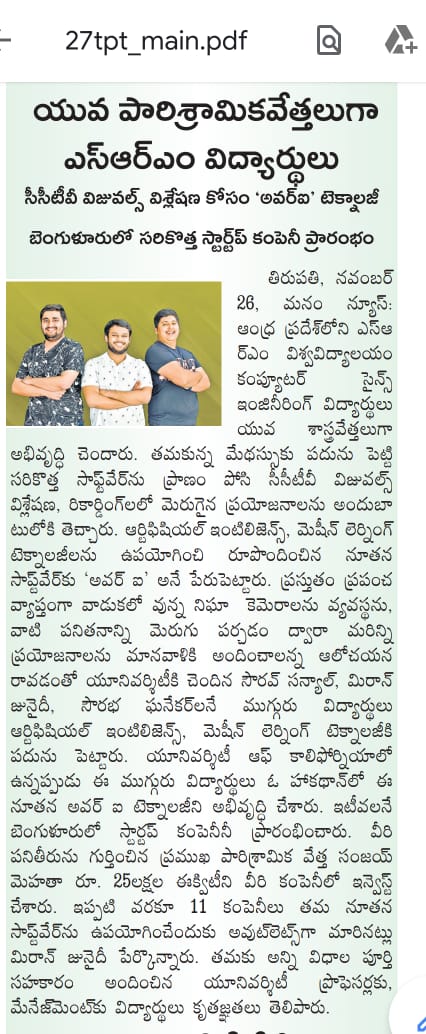
Eenadu – Nov 25
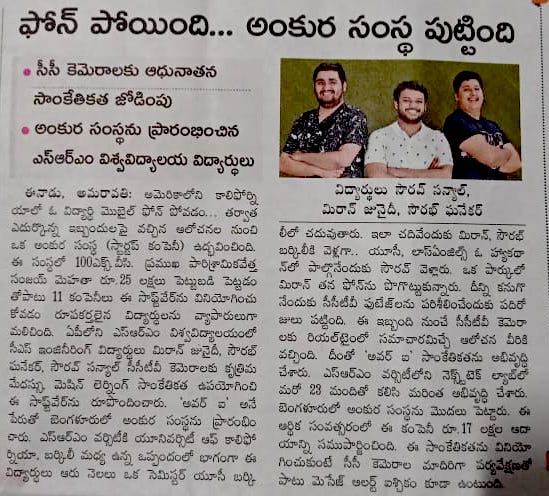
Andhra Jyoti – Nov 25
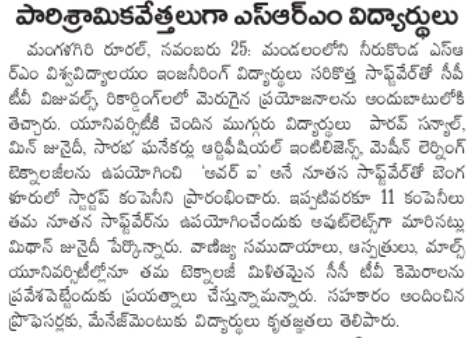
Praja Sakthi – Nov 25
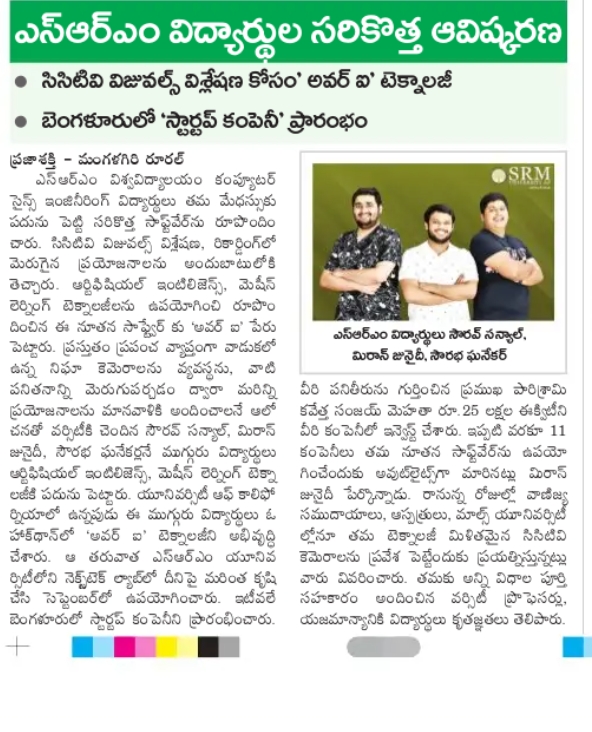
Vartha – Nov 25
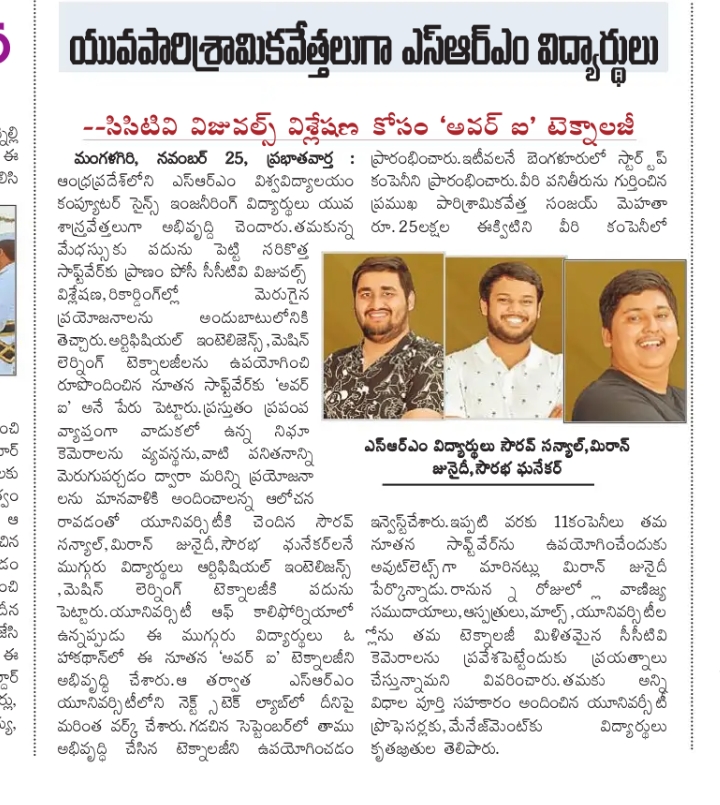
Vartha Prapancham – Nov 25
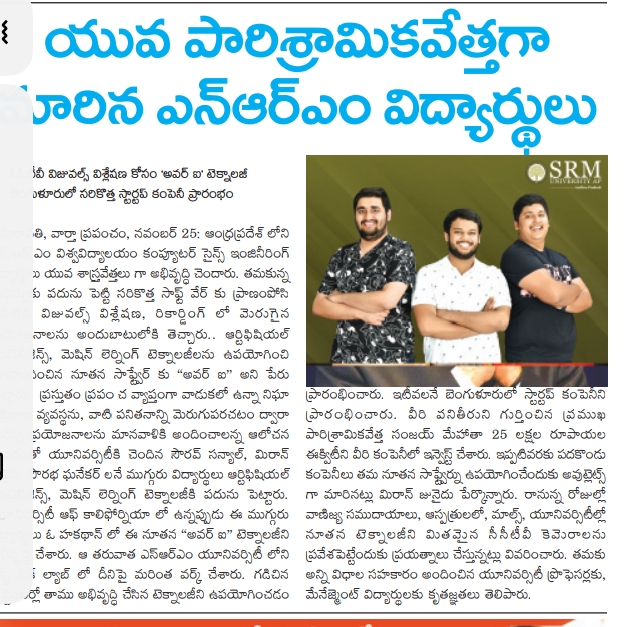
University Distinguished Lecture – Prof Ashuthosh Sharma
The Hindu – Dec 06
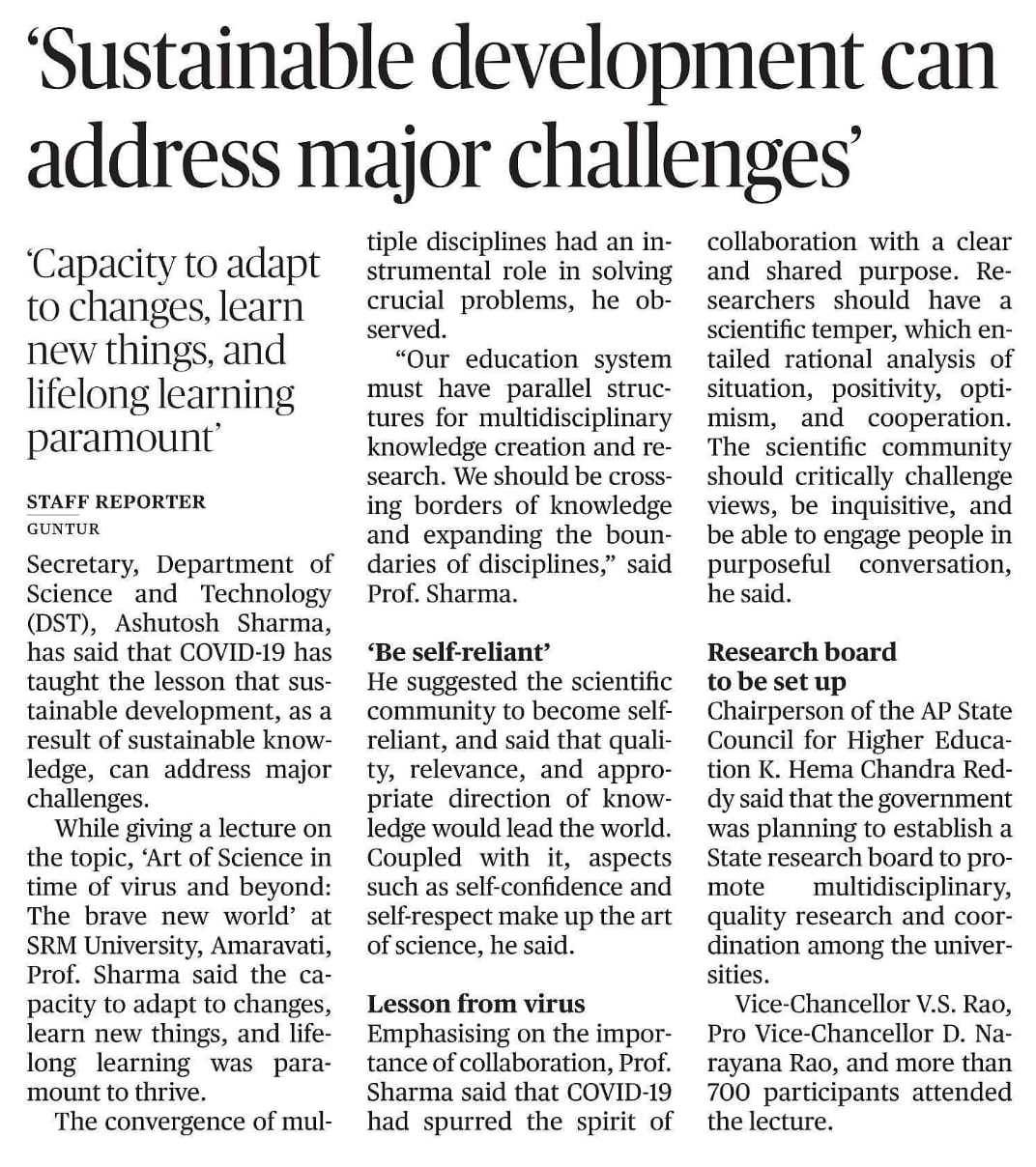
Dainik Jagran Inext – Dec 06
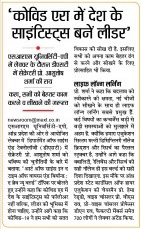
New Indian Express – Dec 06
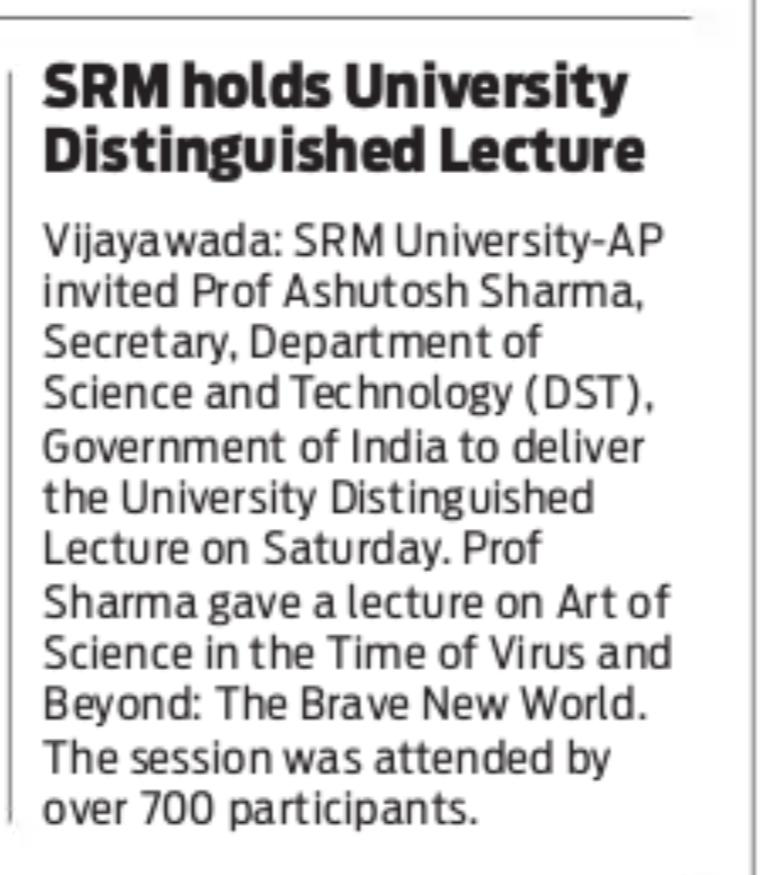
Hans India – Dec 06
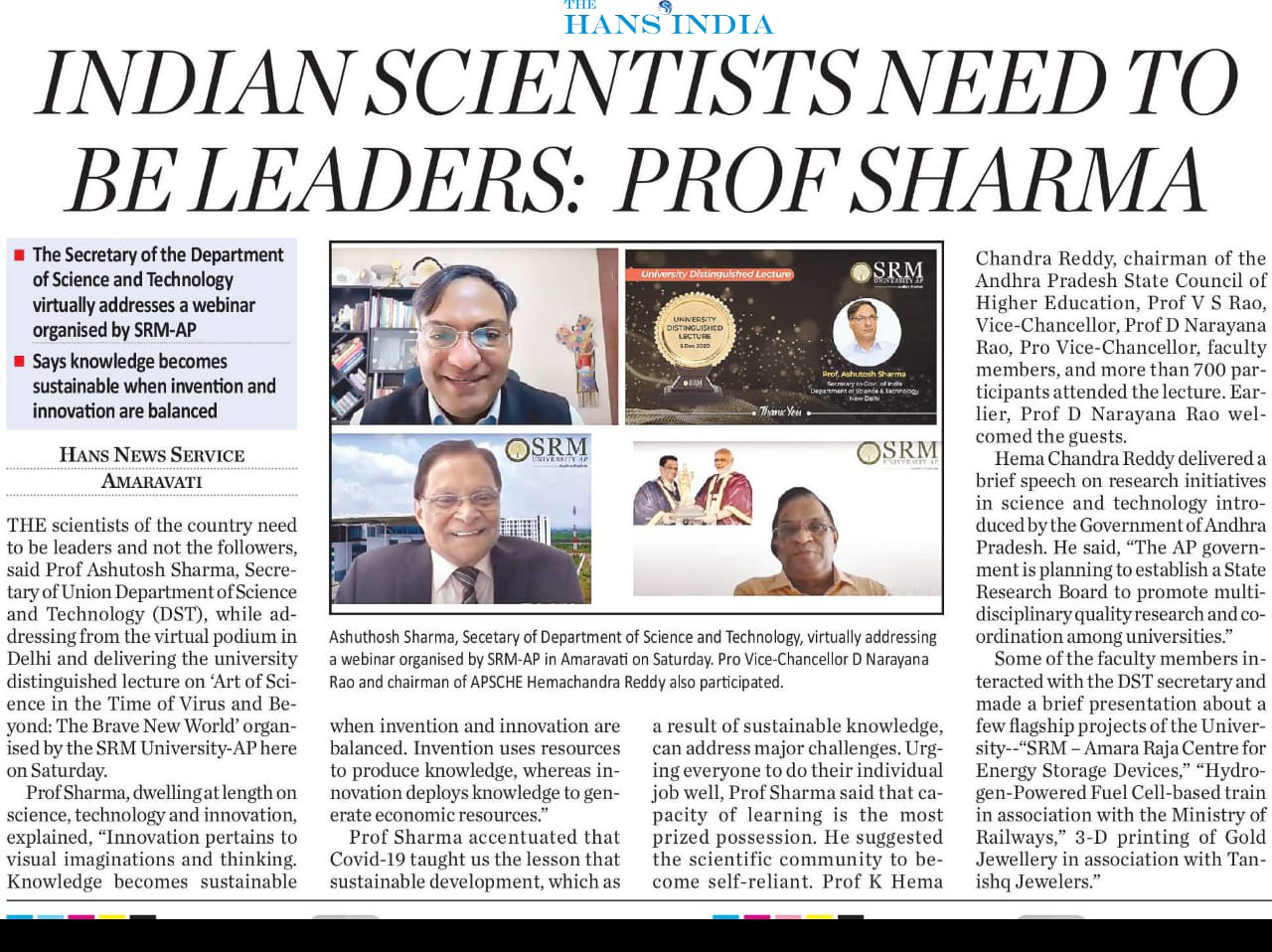
Deccan Chronicle – Dec 06
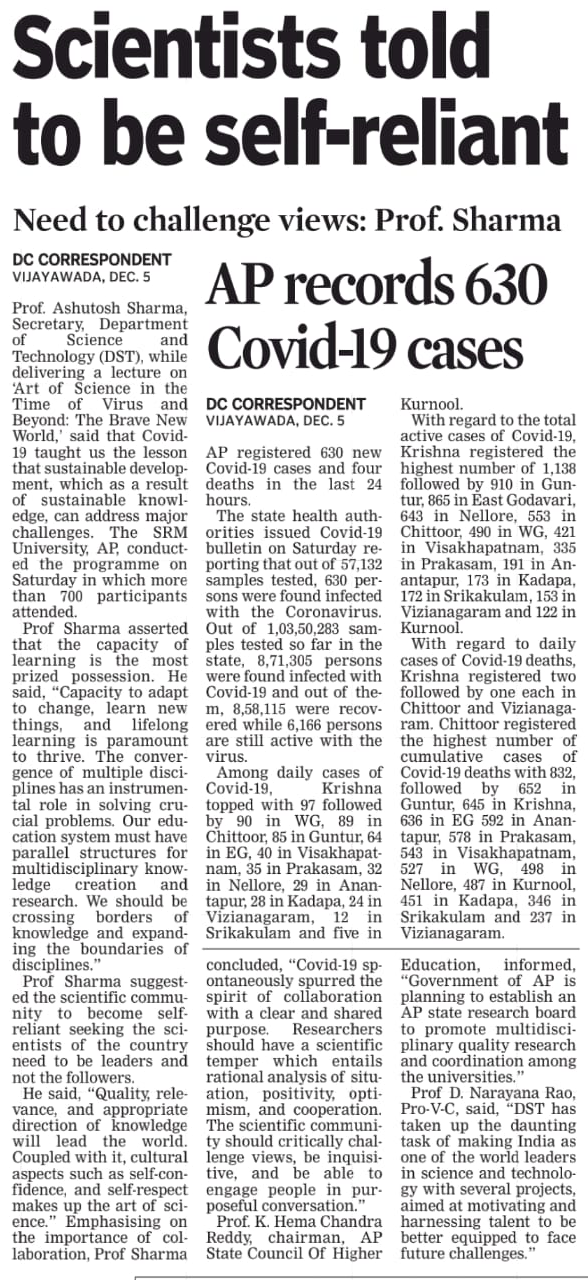
Photo Chronicle – Dec 06
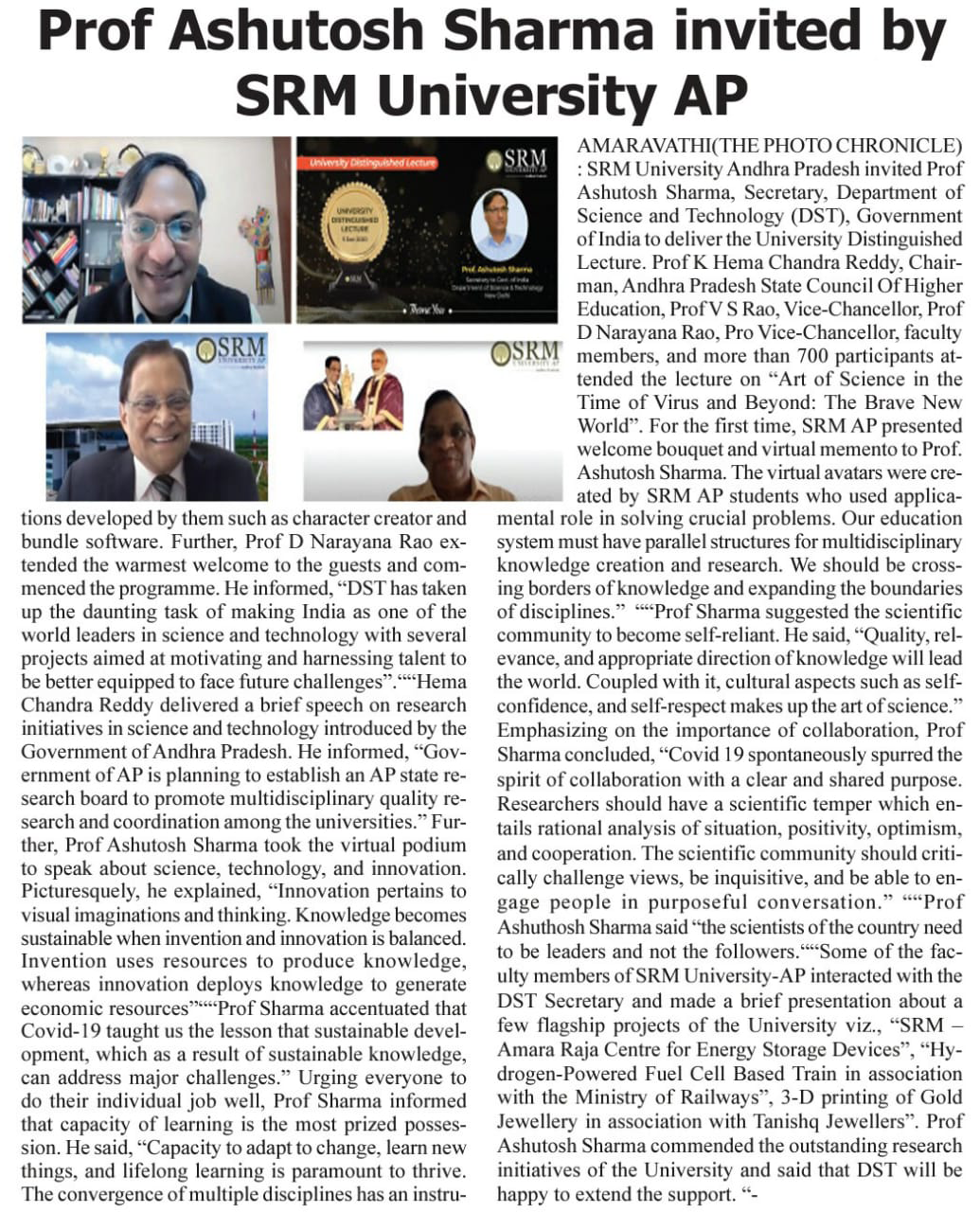
The Pioneer – Dec 06
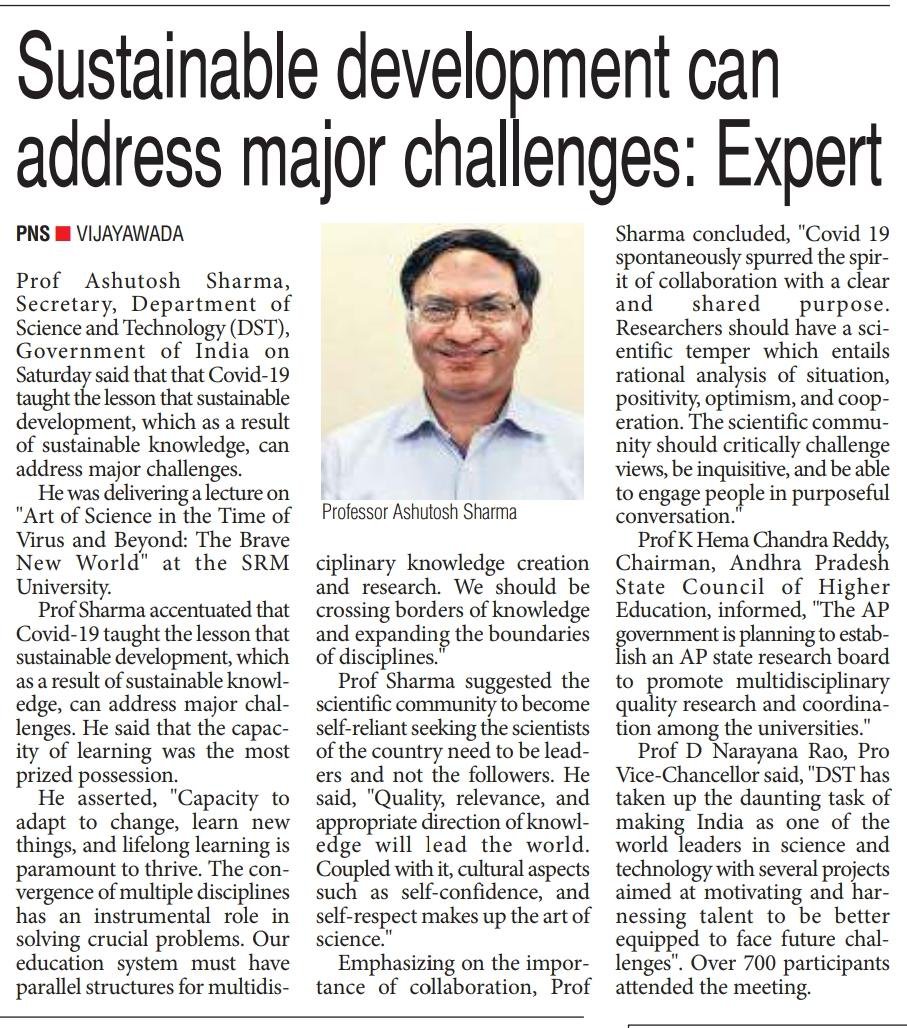
Times of India – Dec 06
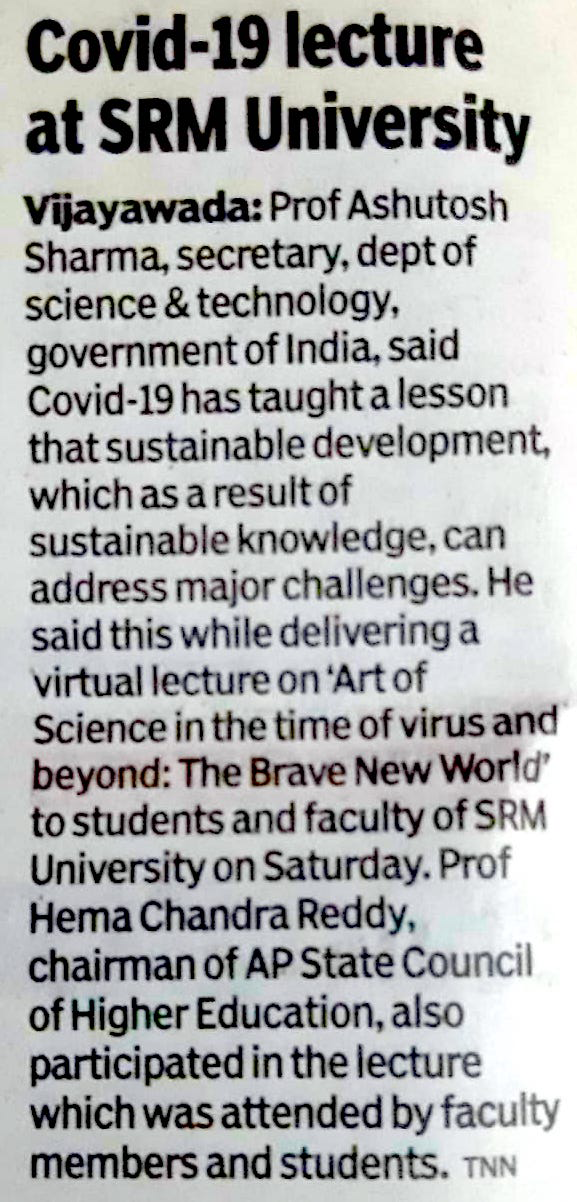
Eenadu – Dec 06
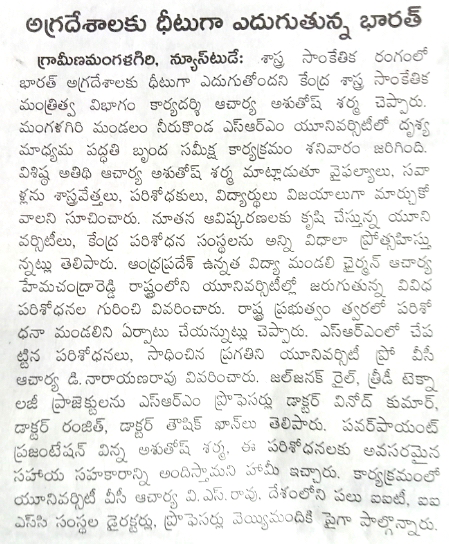
Sakshi – Dec 06
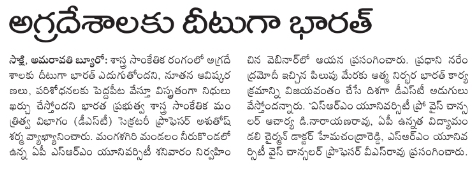
Andhra Prabha – Dec 06

Vaartha – Dec 06
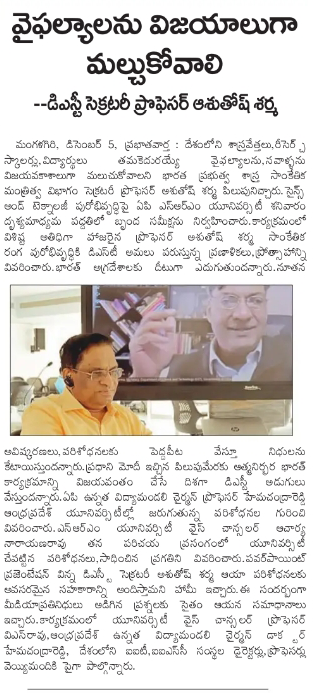
Andhra Jyothi – Dec 06

- Published in Newsroom
Prof C Durga Rao Receive A Grant To Enhance Vaccine Efficacy At A Reduced Cost
- Published in Newsroom
The 5 aspects to look for in a business course to be future ready
Learning business management is a complicated enough exercise with experts divided on whether management is science or art, or both. In the current era, the complications are compounded by the pace of change. Theories and frameworks are getting outdated rapidly and textbooks can be obsolete by the time they reach the student’s desk from the printer. In this scenario, how does a student ensure that the business studies course is keeping him or her future ready? The answer is not easy given the situation, but there are 5 universal aspects that few would dispute.
1. Practical experience
Many business studies courses are geared towards freshers with limited to no work experience. If the course itself offers no avenues for practical experience then the student graduates with a skill handicap. Look for courses that offer hands-on business experience during studies. This can be in the form of industrial projects from real companies, internships, assistance on faculty research projects for companies, or even simple opportunities for interaction with the real business world. Being in actual situations, facing real problems of real people shapes your world view and the sooner you can gain this experience the better. For this, look for institutions that have tie-ups for such opportunities with their recruiters and other corporates.
2. Soft skills
Many business studies courses are geared towards freshers with limited to no work experience. If the course itself offers no avenues for practical experience then the student graduates with a skill handicap. Look for courses that offer hands-on business experience during studies. This can be in the form of industrial projects from real companies, internships, assistance on faculty research projects for companies, or even simple opportunities for interaction with the real business world. Being in actual situations, facing real problems of real people shapes your world view and the sooner you can gain this experience the better. For this, look for institutions that have tie-ups for such opportunities with their recruiters and other corporates.
3. People matter
In a networked and ever-changing business world, no one can function in a silo. Effective team work is essential in an era where multiple perspectives are needed to solve complex problems. And this means people need to be effective at working together. Empathy, accommodation, appreciating diversity, understanding and working with differences, and sensitivity are the key skills that need to be developed for success and these are timeless skills. Institutes that build in team work and people dependencies into course work will help groom managers who can work effectively and efficiently with any group of co-workers. This is why many courses involve a large volume of team assignments, presentations, and projects.
4. Global perspective
Globalisation is a reality that no business, big or small, can ignore and this will only compound in the future as trade and people mobility go up in future. Even an entry level business manager needs to be cognisant, aware, and prepared to work in a complex and interlinked world. How do you achieve this when many entry level managers have not even stepped out of their city of birth? Developing the ability to work with different nationalities, being comfortable in foreign environments, and being able to blend into the unfamiliar are going to be must have skills for the future and preparation needs to begin early. Courses that offer foreign language courses, cross-cultural collaboration opportunities, international exchange programs, diverse pool of international students, and opportunities to learn from foreign visiting faculty are one way to prepare for this business reality.
5. An entrepreneurial approach
Some theoretical concepts are timeless while other whither away. However new approaches to solving old problems and developing abilities to deal with new problems are always evolving. After all, many of the challenges and opportunities seen today did not exist even 5 years ago. How would a graduate from then cope today and how will he/she cope tomorrow? The dynamism needed to face unique situations and problems comes from developing an entrepreneurial mindset in students from an early stage. This mindset can be developed through a pedagogy that focuses on doing, experimenting, failing, learning, unlearning, and taking responsibility for one’s efforts. Courses that spoon feed will soon disappear into the sands of time, as will the students who learned with such approaches.
Bear in mind that there is no course which will teach you all the skills you will need in the future. A course can provide you with timeless skills, some of which are listed above, and it can provide you with a mindset of flexibility, entrepreneurship, ownership, responsibility, and risk taking. If you have these then your skill set is indeed timeless.
- Published in Blog, Management
Engineering Physics: Great Career Choices
What it is
Engineering Physics refers to the combined disciplines of physics, mathematics, and engineering. The field seeks ways to apply, design, and develop new solutions in engineering and holds promising career prospects for interested graduates of science or engineering.
One of the biggest advantages of Engineering Physics is that unlike traditional engineering or science disciplines, it does not restrict itself to one domain. The focus is on applied physics covering highly specialised fields such as quantum physics, materials science, applied mechanics, electronics, nanotechnology, microfabrication, microelectronics, computing, photonics, nuclear engineering, biophysics, control theory, aerodynamics, energy, solid-state physics, and others.
The focus on coming up with integrated solutions sourced from multiple specialities ensures that the solutions thus derived are more optimal, effective, and efficient. The cross-functionality also serves as a bridge for the long-standing gap between the theoretical and practical sides of science and engineering.
Who is it for
As stated, graduates of science or engineering can look to specialise in Engineering Physics. Scientists looking to move beyond theory, or engineers looking to create real solutions to tangible problems using theoretical rigour find this field exciting.
Career prospects
Qualified engineering physicists fit in into opportunities within high technology industries some of which are in emergent domains. Broadly speaking, the roles span research and development, design, and analysis. The industry will depend on the engineering specialisation that is selected, i.e. mechanical, computer, nuclear, aerospace, etc.
Engineering Physics is well poised to grow as a segment specifically because of the many emergent sectors in which it has application as well as the technological progress in the last decade that has created entirely new industries. Some of the key areas that will see job growth are discussed below.
Agro Physics
The pressures of a growing global population and the need for sustainable agriculture are going to [belatedly] lead to science and engineering playing a larger role in how we grow crops. Agro Physics is an evolving field and it involves the study of materials and processes in the sowing, harvesting, and processing of agricultural produce.
Artificial Intelligence
Artificial Intelligence or AI refers to machines that mimic human cognitive functions such as learning and problem solving. This exciting field is growing by leaps and bounds and holds great promise in automation of many processes besides an exponential growth in processing capacities.
Biomechanics
Biomechanics involves the study of the structure, function and motion of the mechanical aspects of living systems. The field touches applications such as aerodynamics, orthopedics, locomotion, pathology, oncology, among others.
Bionanotechnology
Bionanotechnology refers to the combination of nanotechnology and biology. Here, bio systems within nature are used as inspiration for creating new nanodevices or nanoparticles. Nanomedicine is the obvious field that is looking to benefit from the progress made in Bionanotechnology, while agriculture is another sector that will see application of new solutions.
Composite materials
A composite material is made from two or more constituent materials with significantly different physical or chemical properties that, when combined, produce a material with characteristics different from the individual components. The objective could be to make the composite lighter, stronger, harder, softer, resistant, flexible, rigid, etc. While composite materials have existed since ages (concrete and steel are composite materials!), limits in development of new materials are constantly being pushed through progress in Engineering Physics.
Machine learning (ML)
ML is a subset of AI and refers to algorithms and statistical models that computer systems use to perform a task without any instructions input by human operators, relying on patterns and inference instead. ML is beginning to find application across many sectors including primarily Economics, Finance, Forensics, Medicine, Search Engines, etc.
Microfabrication
Miniaturisation of various devices (think about the first cell phones and compare them with devices today) has led to the need for Microfabrication, which is the process of fabricating miniature structures of micrometre scales and smaller. Progress in material science, nanotechnology, and other fields has led to growth in possibilities in this field.
Nanotechnology
Nanotechnology is the manipulation of matter on an atomic, molecular, and supramolecular scale. Apart from medicine, Nanotechnology holds immense potential for multiple industrial sectors such as defence, textiles, food packaging, sports, construction, and energy. The fruits of the research conducted in this exciting field over the years is only just beginning to be realised.
Neural engineering
The human neural system is an extremely complex arrangement linking the brain with the rest of the body. Neuroscience is still making tentative progress in understanding how this system works and this pace has quickened lately thanks to the improvement in imaging systems. Neural engineering is a discipline within bioengineering that uses engineering to understand, repair, replace, or enhance these complex neural systems. Aspects such as Neuroimaging, Neuromechanics, Neuromodulation, Neurorobotics, and Neuroregeneration hold great promise for patients who have been resigned to living with neurological disorders.
Robotics
Robotics is the true combination of Computer, Electronics and Mechanical Engineering with Physics. While Robots have existed since many decades now, the application across more sectors, the sophistication of the robotic systems, and their efficiency are being enhanced through the many technological developments. This will lead to productivity and efficiency gains across multiple sectors.

